Presentations
2022
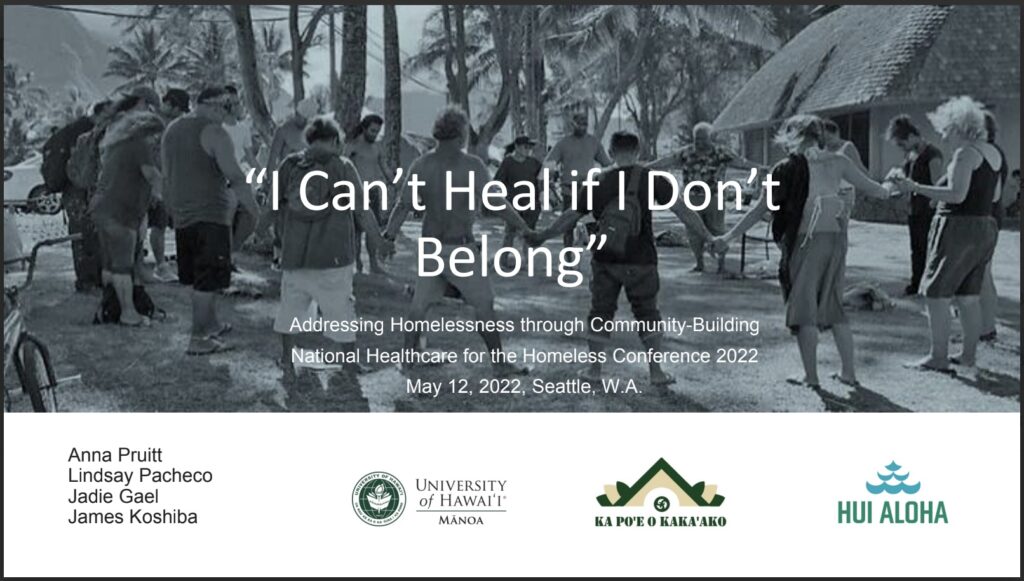
Pruitt, A. S., Pacheco, L., Geil, J., & Koshiba, J. (2022). “I can’t heal if I don’t belong”: Addressing homelessness through community. Paper presented at the 2022 National Health Care For The Homeless Conference & Policy Symposium, Seattle, W.A.
Abstract
Research demonstrates the importance of social support in improving health, decreasing mortality, and enhancing quality of life. Unfortunately, individuals experiencing homelessness often are caught in a “Catch 22” when it comes to accessing housing and gaining/maintaining social support. In order to “climb out of homelessness,” unhoused individuals often have to leave behind the social support networks they built on the streets as a condition of accepting institutional social services. Social services often prioritize the welfare of the individual over the community, and this approach can have the unintended consequence of severing houseless individuals from their supportive network. At the same time, due to the social stigma of homelessness, housed people are often unprepared to welcome houseless or formerly houseless people into their communities, leaving many formerly houseless individuals feeling isolated and desiring to return to the streets. Unfortunately, many governmental and institutional policies compound the issue by reproducing the conditions that lead to divides and inequities between housed and unhoused people and disregard the basic human need to belong. Current approaches have solved neither homelessness nor the larger problem of social isolation and stigmatization in communities. We posit that this failure is because unhoused people have not been involved in developing the policy, programming, and solutions for the problems that affect them.
This presentation will discuss a unique partnership between an advocacy group and leaders of an unhoused community in Honolulu, HI. Together, these groups have engaged in a community-building project that aims to change harmful narratives around homelessness, build leadership and community among houseless individuals, and bridge the gap between housed and unhoused community members. Rooted in the concept of “aloha,” a sense of oneness and centering the perspectives of individuals who have lived experiences, this partnership developed a new model of homelessness service provision and communal living based in Native Hawaiian values. This presentation will present a logic model and evidence for the model as well as will highlight the importance of centering the voices of unhoused individuals in housing and health policy and services.

Barile, J. P., Pruitt, A. S., & Meyer, M. (2022). MAP (Matching to Appropriate Placement): A new assessment for coordinated entry into services. Paper presented at the 2022 National Health Care For The Homeless Conference & Policy Symposium, Seattle, W.A.
Abstract
Within housing and homelessness services, scarce resources need to be efficiently and equitably distributed across vulnerable and hard-to-reach populations. Continuums of Care (CoC) aim to improve coordination and distribution of local services in a given region (Wong et al., 2006). One component of a CoC is utilizing a coordinated entry system (CES) to systematically assess, triage, and place individuals into services in a standardized way. However, common assessments for CES, such as the Vulnerability Index – Service Prioritization Decision Assistance Prescreen Tool (VI-SPDAT), have shown evidence of poor validity, test-retest reliability, and inter-rater reliability (Brown et al., 2018; Salim, 2020), and potential systematic biases across race and ethnicities that may result in inequitable distribution of resources (Barthel et al., 2020; Wilkey et al., 2019). Additional concerns include the lack of ability to leverage local and national data from people not experiencing homelessness to set benchmarks, and limited capacity to match people to programs that best fit their needs.
To address these concerns, we developed the Matching to Appropriate Placement (MAP) tool that aims to match people to services based on a holistic range of criteria, as opposed to prioritizing solely based on vulnerability. The 22 item measure assesses (1) health and wellness, (2) violence exposure and safety, (3) crisis involvement, (4) criminal justice engagement, (5) housing history, and (6) need for crisis intervention. The goals of the assessment are to place individuals’ unique responses patterns to appropriate housing placements that will maximize people’s chances for appropriate placement and distribute resources equitably and efficiently. Improving assessment in CES is an important step for improving client outcomes by reducing rates of failed referrals and recidivism after placement, and increasing client autonomy regarding which services they are placed in. This presentation will (1) describe the MAP tool, (2) present preliminary psychometric and measurement invariance findings, and (3) provide best practices for administration.
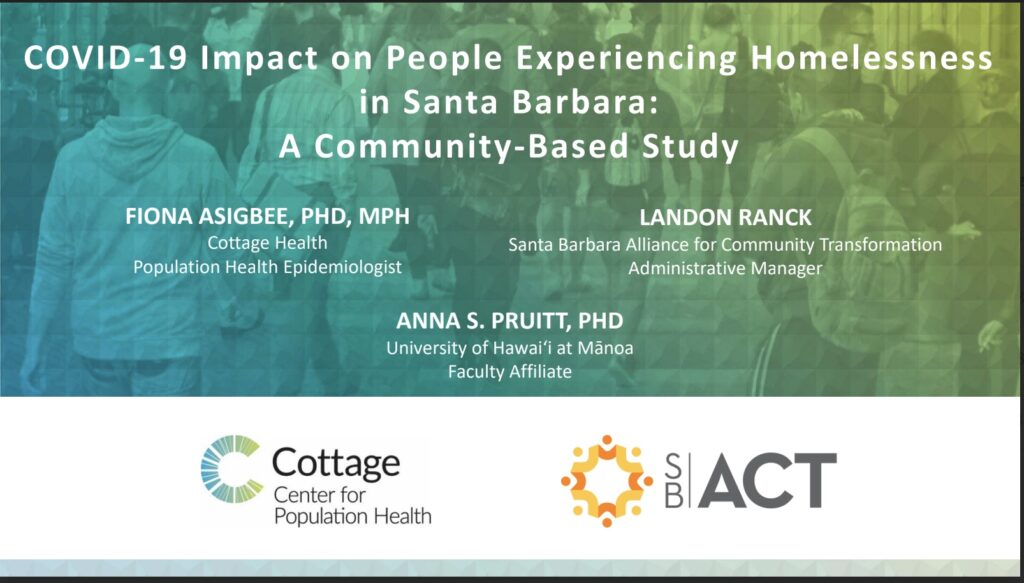
Asigbee, F., Pruitt, A. S., & Ranck, L. (2022). Using photovoice to examine the effects of the COVID-19 pandemic on the homelessness community. Workshop presented at the 2022 National Health Care For The Homeless Conference & Policy Symposium, Seattle, W.A.
Abstract
This workshop will discuss the potential of community-based participatory research (CBPR) methods for understanding lived experiences with homelessness and creating trust and belonging. Based on a Photovoice study examining how the COVID-19 pandemic is impacting people experiencing homelessness in a California county, lessons learned from engaging in CBPR during a pandemic will be discussed. Researchers will share strategies for collecting data from a variety of homelessness communities (e.g., unsheltered, sheltered, and vehicular) and will explore best practices for engaging multiple community partners and building trust within the homelessness community. Using a photo wall and lived experiences of co-researchers, this workshop will demonstrate how CBPR can empower homeless
communities.
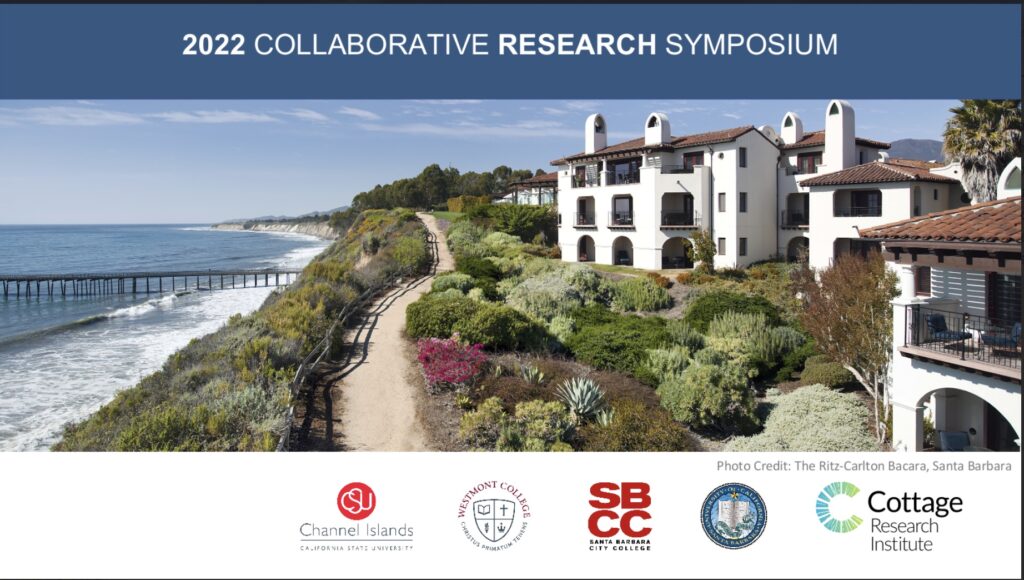
Asigbee, F., Ranck, L., Pruitt, A. S., Pines, R., Ray, M., Silva, C., Barrett, L., & Petras, J. (2022). COVID-19 impact on people experiencing homelessness in Santa Barbara: A community-based study. Paper presented at Cottage Health Research Institute’s 2022 Collaborative Research Symposium, Santa Barbara, C.A.
Abstract
This research study aims to better understand the impact of the COVID-19 pandemic on people experiencing homelessness in South Santa Barbara County, California. The findings of this study can inform local decision making and response efforts to the current and future pandemic/s that specifically impact people experiencing homelessness. The findings can also inform Cottage Health in terms of emergency planning and including special considerations around serving people experiencing homelessness during the pandemic. Furthermore, this study has the potential to be a useful addition to the growing body of knowledge that can influence COVID-19 related initiatives at the national and global level.
2021
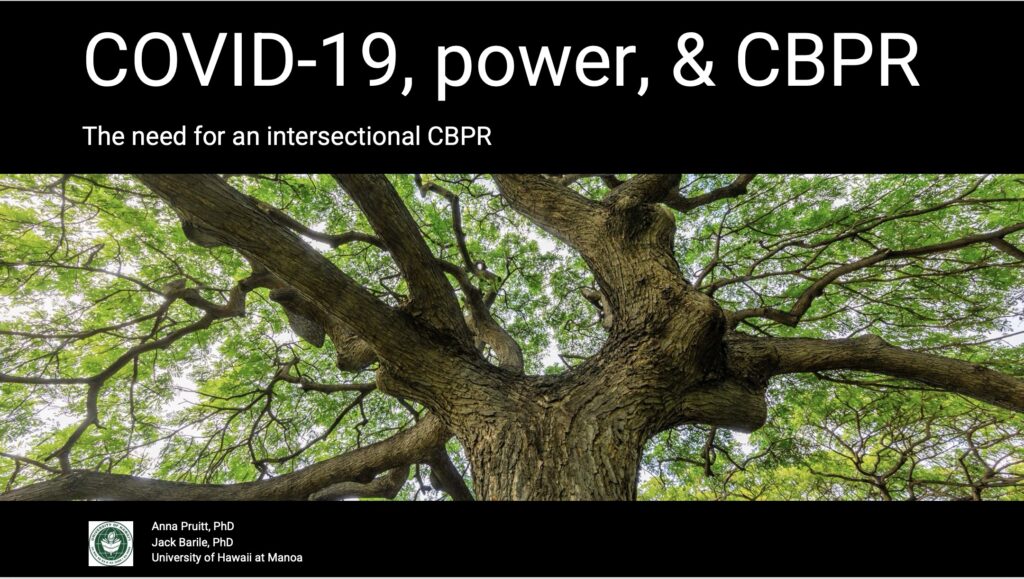
Pruitt, A. S., & Barile, J. P. (2021). COVID-19, power, and CBPR: The need for an intersectional CBPR. Paper presented at the Society for Community Research and Action Biennial Conference [virtual].
Abstract
A key principle of community-based participatory research (CBPR) is the development of equitable partnerships through a power-sharing process (Israel et al., 2013). This principle is one of the most difficult to achieve—in part, because “power-sharing” involves a complex redistribution of power if the partnership is to be truly participatory (Travers et al., 2013). As Arnstein said “participation without redistribution of power is an empty and frustrating process for the powerless” (p. 216). Not only is power-sharing difficult to do, but also it is difficult to evaluate. For example, how do we know when power has been redistributed equitably? In our CBPR project with a transitional housing program on Oʻahu, we found that the COVID-19 pandemic intensified those difficulties. This presentation will discuss the impacts of COVID-19 on power dynamics and will suggest the need for an “intersectional CBPR.”
Intersectionality is useful for understanding and addressing complex power dynamics (Collins, 2015). This presentation will take an intersectional approach to understanding COVID-19 impacts on a diverse partnership comprised of stakeholders positioned along varying axes of power. Partners include program staff, administrators, an advocacy group, local houseless community leaders, evaluators, and residents in the program. The partnership is racially diverse, with no racial group having a majority and includes housed and unhoused stakeholders. Research shows that inequities are often exacerbated in times of crisis and, as a result, power dynamics are laid bare (Weber, 2014). Indeed, COVID-19 allowed for higher-powered partners to wield more influence but also made that power more explicit and created opportunities for advancing the partnership’s agenda—building community through a return to kauhale living (traditional Native Hawaiian village model). We will discuss the implications of race and housing status in relation to power and the benefits of taking an intersectional approach to CBPR projects during and after COVID-19.
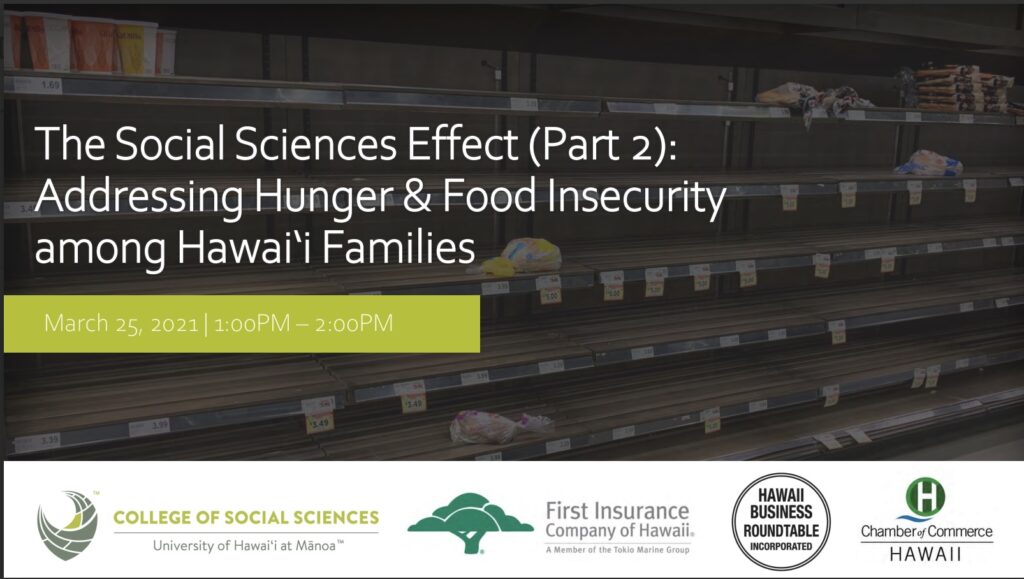
Pruitt, A. S., Zhang, W., Wu, Y., Bird, O., Nakamura, B. & Barile, J. P. (2021). Addressing Hunger & Food Insecurity among Hawaiʻi’s Families. Webinar hosted by Hawai‘i Business Roundtable, First Insurance Company of Hawai‘i, & the UH Mānoa College of Social Sciences. Honolulu, H.I. [virtual]. Full report available here. Video recording available here.
Abstract
An estimated one in three children in Hawaiʻi lived in a food insecure household in 2020. In other words, almost 90,000 children in Hawaiʻi lived in a household that lacked access to enough food for an active, healthy life for all household members. This estimation largely is due to preexisting poverty and the state’s high rates of unemployment attributed to the COVID-19 Pandemic. In addition to rising unemployment, educators and policymakers have wondered if school closures have contributed to family food insecurity, particularly for the approximately 93,000 children statewide who received in-school reduced-price/free meals.
This project sought to understand these factors and the overall impact of COVID-19 on hunger and food insecurity among Hawaiʻi families with school-aged children. We must understand the extent of this issue because childhood food insecurity can have short- and long-term impacts on health & wellbeing. Addressing food insecurity among families with children is imperative for the future of Hawaiʻi.
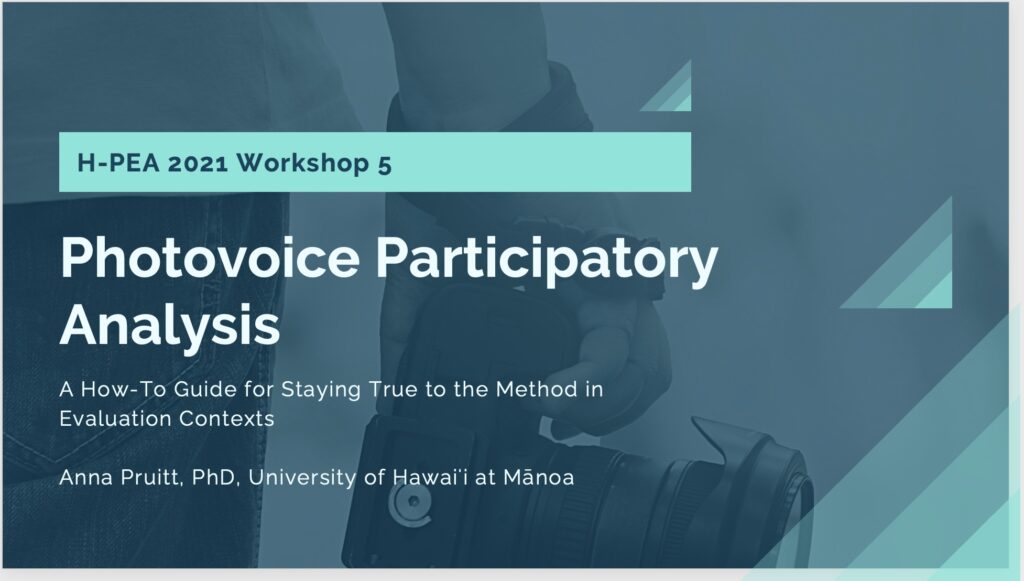
Pruitt, A. S. (2021). Photovoice participatory analysis: A how-to-guide for staying true to the method in evaluation contexts. Invited workshop given for the Hawaiʻi-Pacific Evaluation Association.
Abstract
Photovoice (PV) is a participatory research methodology that uses photography to (a) identify issues of concern; (b) engage in critical dialog about these issues; and (c) communicate these issues to higher-powered stakeholders (Wang, 1999). In evaluation contexts, PV engages individuals who are typically “participants” as co-evaluators in the evaluation process. As such, PV is well-suited for transformative participatory evaluations that seek to create conditions in which individuals who have traditionally had little access to power can empower themselves (Cousins & Chouinard, 2012). Despite PV’s benefits, evaluators and researchers often struggle with the participatory analysis stage, which is rarely described in project summaries or methods sections (Catalini & Minkler, 2010). As a result, many PV projects fall back on traditional researchers’ interpretations of data. This workshop will provide a how-to for PV participatory analysis, including tips for remaining participatory at this important – and often misunderstood – stage of the PV process.
WHAT YOU WILL LEARN
- When to use either Photovoice (participatory) and photo-elicitation (participatory-inspired) methodologies
- How to engage in Photovoice participatory content analysis in a rigorous and ethical way
- Understand the difference between Photovoice (participatory) and photo-elicitation (participatory-inspired) methodologies
2020
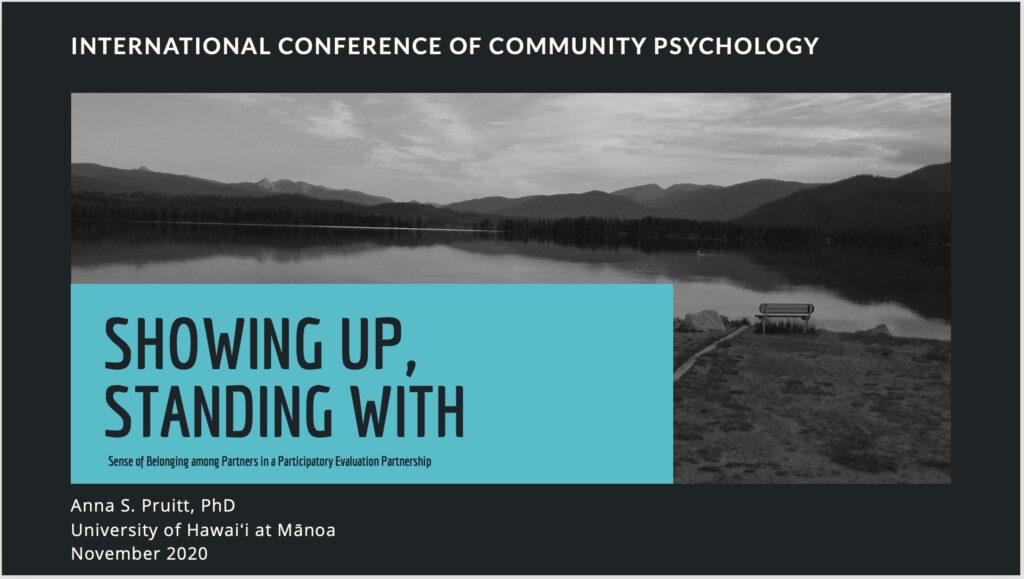
Pruitt, A. S. (2020). Showing up, standing with: Sense of belonging among partners in a participatory evaluation partnership. Paper presented at the 8th International Conference of Community Psychology. Melbourne, AU [virtual].
Abstract
Decades of research underscore the importance of social support in improving health, decreasing perceived stigma, decreasing mortality, and enhancing quality of life. Unfortunately, we know very little about the conditions that lead to supportive relationships, particularly among people with severe and persistent mental illness, who are more likely to suffer from isolation. This presentation combines findings from a longitudinal Photovoice project with individuals in a Housing First program, a multi-site Photovoice project with mental health Clubhouses, and a pilot program to re-engage individuals with HIV in medical care, to consider aspects of the environment that enhance or prevent a sense belonging. In addition to sharing insights from three unique programs, we will discuss the potential for participatory research to increase social support and sense of belonging among marginalized individuals.
The first presentation will define social support and its importance for individual and community wellbeing, specifically for individuals with HIV. It will discuss findings from a recent a HIV Treatment as Prevention project, highlighting the negative impacts lack of social support has for individuals living with HIV, and how they might be ameliorated. The second presentation will examine the role of mental health Clubhouses in creating community for individuals with severe and persistent mental illness. Specifically, we look at how individuals made to feel welcome and engaged in Clubhouse activities, the importance of having a dignified space, and the impact that that Clubhouse participation has on member’s quality of life. The third will discuss a 4-year longitudinal Photovoice study with Housing First participants. Relevant findings suggest that having projects and hobbies that “give back” to the community gave individuals a sense of purpose, created a sense of belonging to the community, and aided individuals in dealing with continuing stigma. Presenters will focus both project findings and process, providing insights on how research itself can create a safe place where participants are valued and contributing members.
Finally, audience members will be encouraged to reflect upon and contribute their insights to the conversation from their own practices, scholarship, and theoretical backgrounds. In particular, the audience will be asked to consider what “belonging” means for them in their own research and practice; how or if they consider “belonging” and other aspects of social support when designing their research projects; and how they create belonging within their own professional environments.
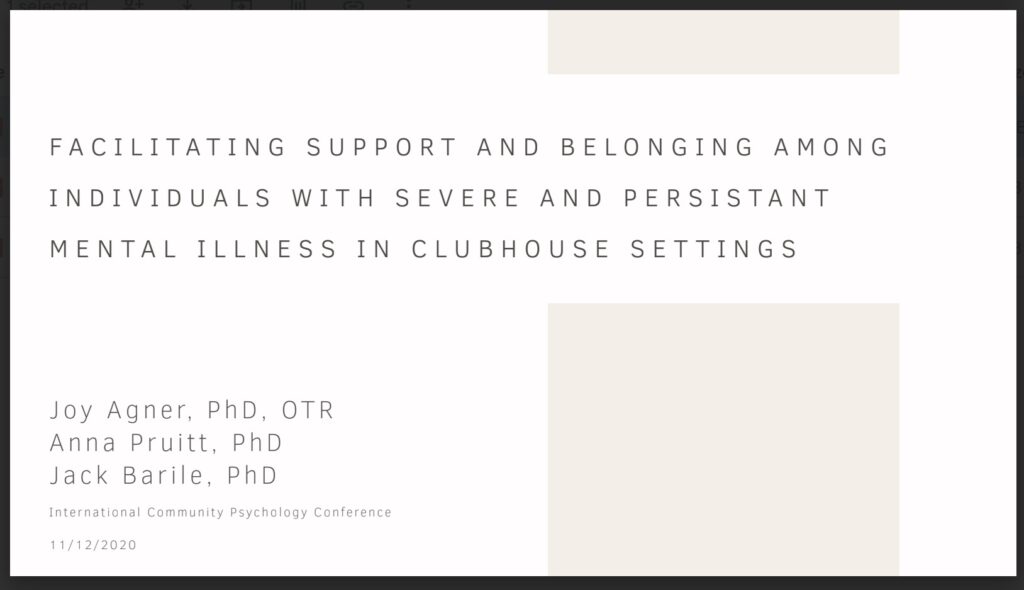
Agner, J., Pruitt, A. S., Barile, J. P. (2020). Facilitating support and belonging among individuals with severe and persistent mental illness in Clubhouse settings. Paper presented at the 8th International Conference of Community Psychology. Melbourne, AU [virtual].
Abstract
Decades of research underscore the importance of social support in improving health, decreasing perceived stigma, decreasing mortality, and enhancing quality of life. Unfortunately, we know very little about the conditions that lead to supportive relationships, particularly among people with severe and persistent mental illness, who are more likely to suffer from isolation. This presentation combines findings from a longitudinal Photovoice project with individuals in a Housing First program, a multi-site Photovoice project with mental health Clubhouses, and a pilot program to re-engage individuals with HIV in medical care, to consider aspects of the environment that enhance or prevent a sense belonging. In addition to sharing insights from three unique programs, we will discuss the potential for participatory research to increase social support and sense of belonging among marginalized individuals.
The first presentation will define social support and its importance for individual and community wellbeing, specifically for individuals with HIV. It will discuss findings from a recent a HIV Treatment as Prevention project, highlighting the negative impacts lack of social support has for individuals living with HIV, and how they might be ameliorated. The second presentation will examine the role of mental health Clubhouses in creating community for individuals with severe and persistent mental illness. Specifically, we look at how individuals made to feel welcome and engaged in Clubhouse activities, the importance of having a dignified space, and the impact that that Clubhouse participation has on member’s quality of life. The third will discuss a 4-year longitudinal Photovoice study with Housing First participants. Relevant findings suggest that having projects and hobbies that “give back” to the community gave individuals a sense of purpose, created a sense of belonging to the community, and aided individuals in dealing with continuing stigma. Presenters will focus both project findings and process, providing insights on how research itself can create a safe place where participants are valued and contributing members.
Finally, audience members will be encouraged to reflect upon and contribute their insights to the conversation from their own practices, scholarship, and theoretical backgrounds. In particular, the audience will be asked to consider what “belonging” means for them in their own research and practice; how or if they consider “belonging” and other aspects of social support when designing their research projects; and how they create belonging within their own professional environments.
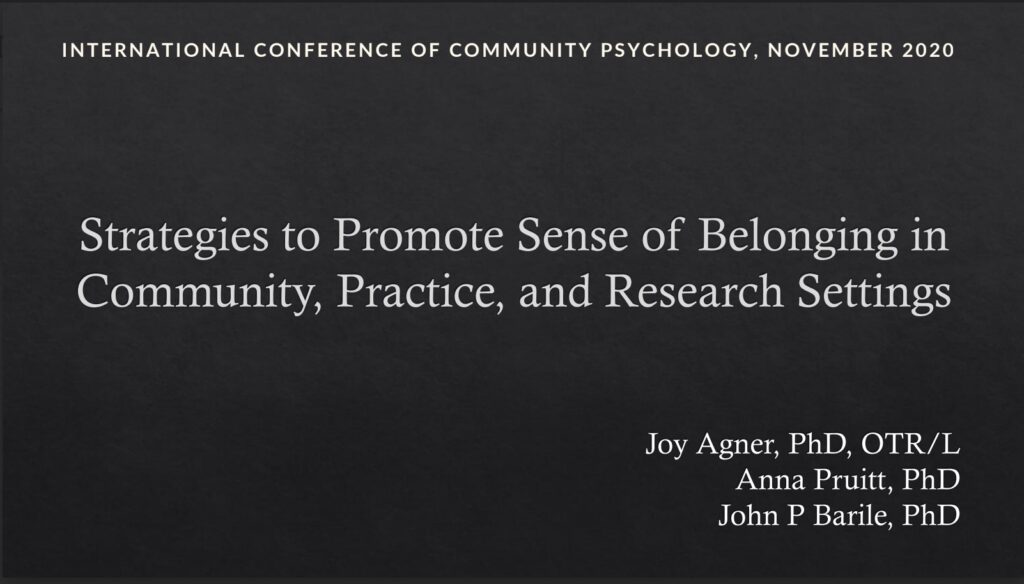
Agner, J., Pruitt, A. S., Barile, J. P. (2020). Strategies to Promote Sense of Belonging in Community, Practice, and Research Settings. Symposium held at the 8th International Conference of Community Psychology. Melbourne, AU [virtual].
Abstract
Decades of research underscore the importance of social support in improving health, decreasing perceived stigma, decreasing mortality, and enhancing quality of life. Unfortunately, we know very little about the conditions that lead to supportive relationships, particularly among people with severe and persistent mental illness, who are more likely to suffer from isolation. This presentation combines findings from a longitudinal Photovoice project with individuals in a Housing First program, a multi-site Photovoice project with mental health Clubhouses, and a pilot program to re-engage individuals with HIV in medical care, to consider aspects of the environment that enhance or prevent a sense belonging. In addition to sharing insights from three unique programs, we will discuss the potential for participatory research to increase social support and sense of belonging among marginalized individuals.
The first presentation will define social support and its importance for individual and community wellbeing, specifically for individuals with HIV. It will discuss findings from a recent a HIV Treatment as Prevention project, highlighting the negative impacts lack of social support has for individuals living with HIV, and how they might be ameliorated. The second presentation will examine the role of mental health Clubhouses in creating community for individuals with severe and persistent mental illness. Specifically, we look at how individuals made to feel welcome and engaged in Clubhouse activities, the importance of having a dignified space, and the impact that that Clubhouse participation has on member’s quality of life. The third will discuss a 4-year longitudinal Photovoice study with Housing First participants. Relevant findings suggest that having projects and hobbies that “give back” to the community gave individuals a sense of purpose, created a sense of belonging to the community, and aided individuals in dealing with continuing stigma. Presenters will focus both project findings and process, providing insights on how research itself can create a safe place where participants are valued and contributing members.
Finally, audience members will be encouraged to reflect upon and contribute their insights to the conversation from their own practices, scholarship, and theoretical backgrounds. In particular, the audience will be asked to consider what “belonging” means for them in their own research and practice; how or if they consider “belonging” and other aspects of social support when designing their research projects; and how they create belonging within their own professional environments.
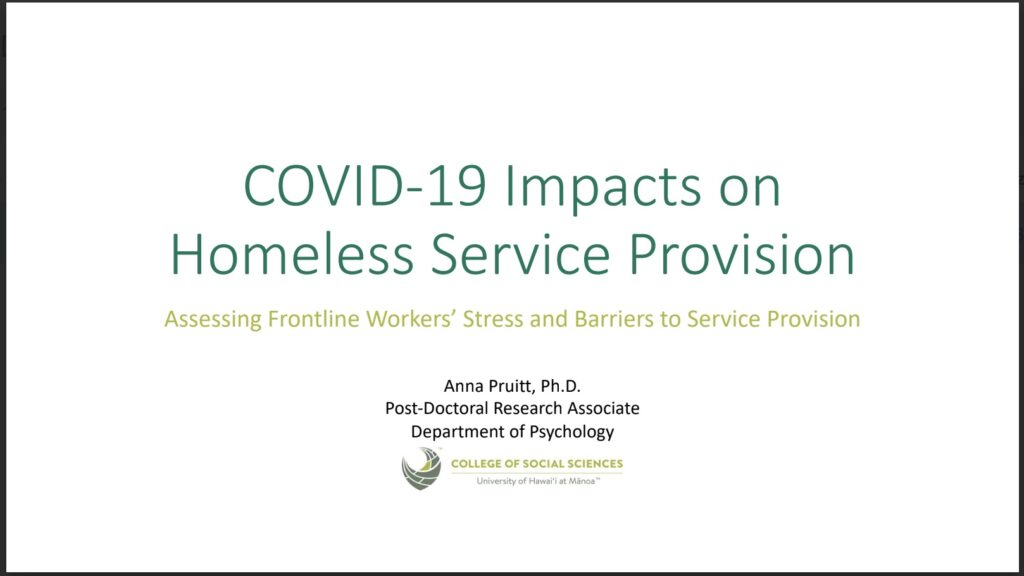
Pruitt, A. S. (2020). COVID-19 impacts on homeless service provision: Assessing frontline workers’ stress and barriers to service provision. Social Impacts of COVID-19 in Hawai‘i: Homelessness, Families with Young Children, Drivers of Health and Socioeconomic Disparities, and COFA Migrants. Webinar hosted by Hawai‘i Business Roundtable, First Insurance Company of Hawai‘i, & the UH Mānoa College of Social Sciences. Honolulu, H.I. [virtual]. Full report available here.
Abstract
The U.S. Centers for Disease Control warns that individuals experiencing homelessness are at increased risk for contracting COVID-19 and for developing severe disease. Homeless service providers also can be at increased risk for contracting COVID-19 due to their close contact with at-risk groups, as well as are at risk for mental health complications, such as burnout and stress. Thus, the COVID-19 Pandemic may have disproportionately negative impacts on individuals experiencing homelessness and the individuals who serve them.
This exploratory study sought to understand the impacts of COVID-19 on homeless service provision on O‘ahu. In particular, it examined needs and risk factors of individuals experiencing homelessness; frontline workers’ needs and stress levels; and the challenges of serving vulnerable populations during the pandemic. Preliminary results suggest that service providers—particularly outreach workers—have conducted a significant number of COVID-19 screenings but have reached only a small percentage of the homeless population and may be experiencing stress and burnout. Additionally, findings suggest that pre-existing needs of individuals experiencing homelessness (e.g., permanent housing and mental health services) have increased due to COVID-19.
2019
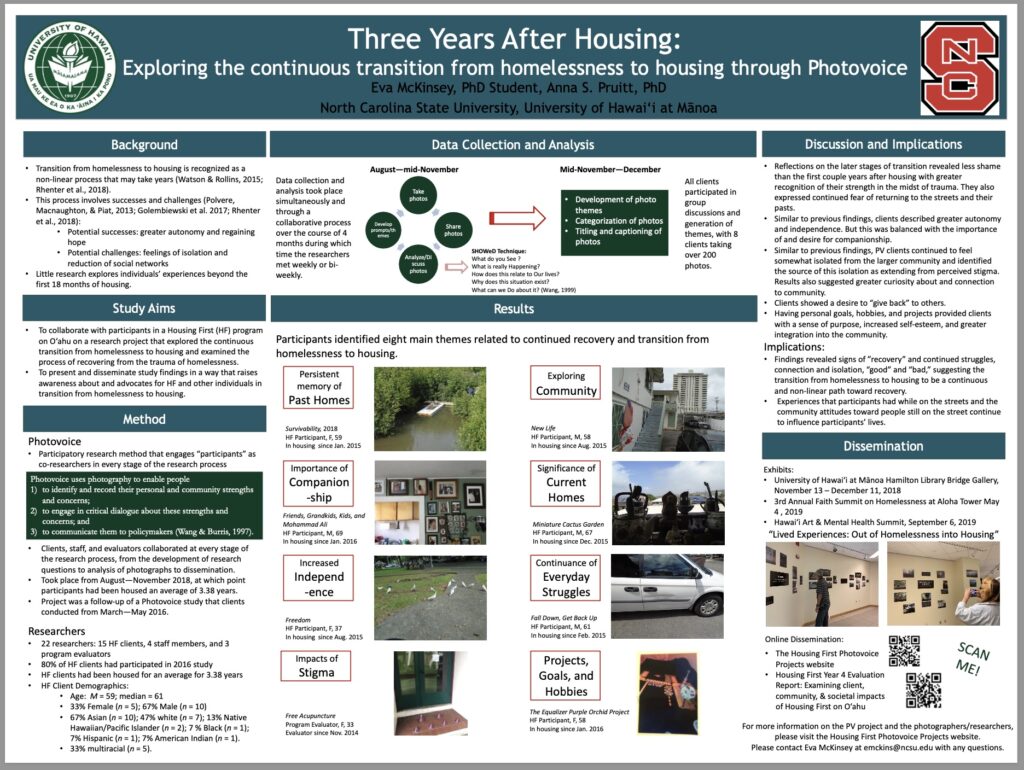
McKinsey, E., & Pruitt, A. S. (2019). Three Years After Housing: Exploring the continuous transition from homelessness to housing through Photovoice. Poster presented at Southeastern Eco Conference, Back to Basics: Reaffirming the Core Values of Community, Columbia, S.C.
Abstract
The transition from homelessness to housing, and specifically, recovery from homelessness, has been recognized as a non-linear process that may take years (Watson & Rollins, 2015; Rhenter et al., 2018). For many individuals, this process involves successes, such as developing greater autonomy and regaining hope for the future (Polvere, Macnaughton, & Piat, 2013; Golembiewski et al. 2017; Rhenter et al., 2018). It may also involve challenges associated with feelings of isolation and reduction of social networks. Despite the understanding that the transition from homelessness to housing may span years, little research has sought to understand the experiences of individuals in the later stages of such a transition. This photovoice study explored the experiences of participants in a Housing First (HF) program on O‘ahu from August—November of 2018, at which point, participants had been housed an average of 3.38 years. The study included 22 individuals: 15 HF clients, 4 staff members, and 3 evaluators. Through the use of Photovoice—a participatory research method that engages “participants” as co-researchers (Wang & Burris, 1997)—HF clients used photography to explore meaningful aspects of their lives, with a focus on their continuous transition from homelessness to housing. HF clients, staff, and evaluators collaborated at every stage of the research process, from the development of research questions and analysis of photographs to dissemination. This poster will present the stages of the collaborative research process and the preliminary findings of the study based on the initial analysis of photographs conducted primarily by HF clients and evaluators. Through analysis, participants identified eight main themes related to continued recovery and transition from homelessness to housing: the persistent memory of past homes, significance of current homes, exploring their community, desire for companionship, increased independence, continuance of everyday struggles, impacts of stigma, and the importance of having personal projects, goals, and hobbies. Dissemination of study results and implications will also be presented.
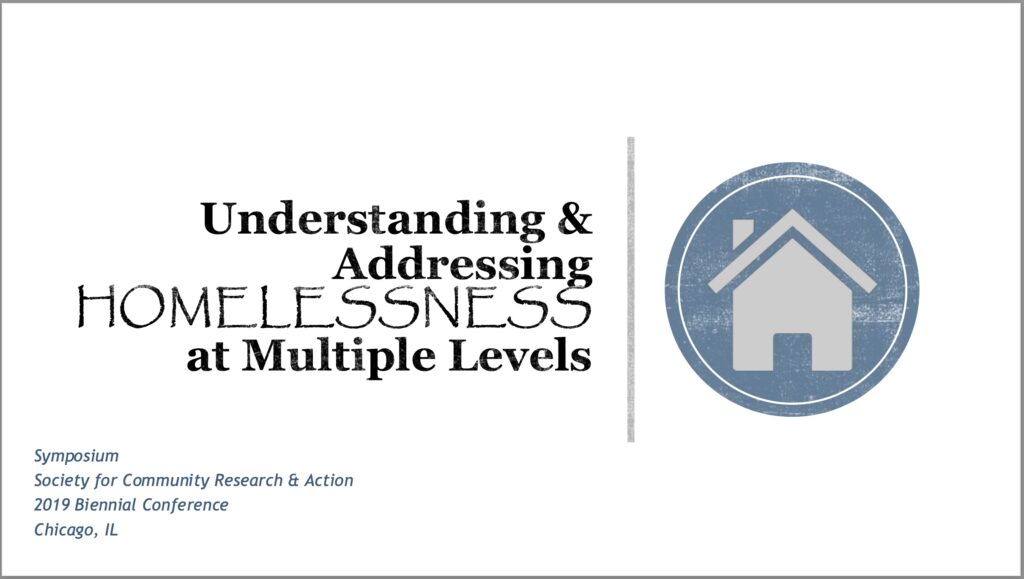
Pruitt, A. S., & Gleason, K. (2019). Understanding and addressing homelessness at multiple levels. Symposium presented at the Society for Community Research and Action Biennial Conference, Making an Impact: Ecological Praxis: System Complexity, Cycles of Action, and Extending our Metaphors with the Natural World, Chicago, I.L.
Abstract
Community Psychology has long acknowledged the influence of settings, systems, and societal structures in shaping human behavior and community health (O’Donnell, 2006). The discipline largely arose as a reaction against overly individualistic explanations for social problems. Despite these values, community psychology methods and approaches often focus on individual level data and do not capture the contextualized understandings that we seek to generate (Luke, 2005). Like many complex social issues, homelessness plays out across multiple levels and thus, understanding this prevailing social issue and addressing it effectively requires research that addresses multiple levels. This symposium will include presentations on research and interventions that approach homelessness from varying levels and use innovative methods to capture context. The first presentation will include an analysis of dominant cultural narratives on homelessness—a macro-level approach. The second presentation will discuss a study that used geographic information systems analysis to examine homeless service gaps in rural Maine. The third zooms in to community-level considerations by examining the impact of a community’s homelessness crisis on a law enforcement diversion program. The last presentation focuses on program-level factors by examining different trajectories of persons in a Housing First program. Taken together, these presentations highlight the complexity of homelessness and emphasize the need for research and interventions that reflect an ecological understanding of the issue.
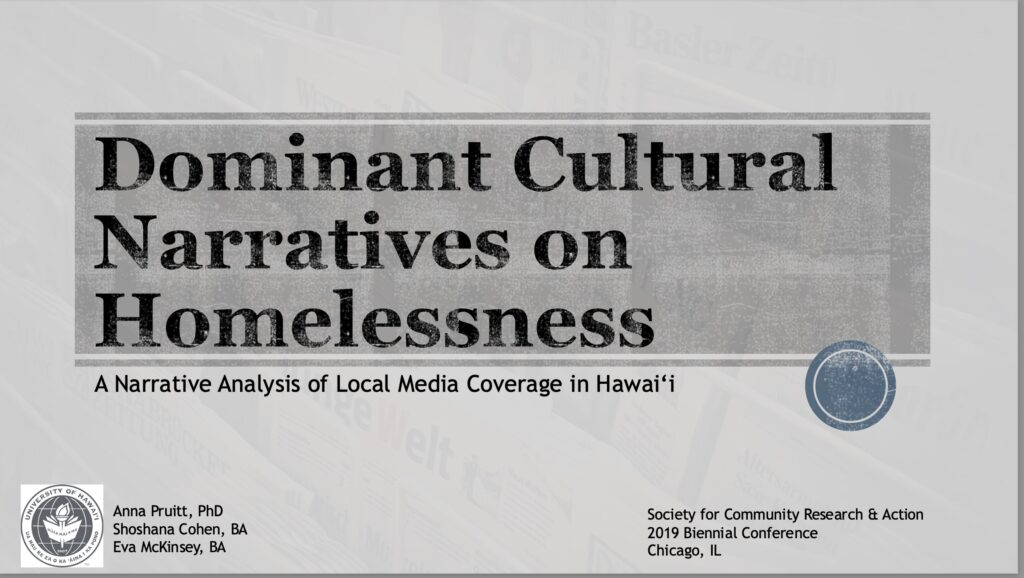
Pruitt, A. S., Cohen, S., & McKinsey, E. (2019). Dominant cultural narratives on homelessness: A narrative analysis of local media coverage on O‘ahu. Paper presented at the Society for Community Research and Action Biennial Conference, Making an Impact: Ecological Praxis: System Complexity, Cycles of Action, and Extending our Metaphors with the Natural World, Chicago, I.L.
Abstract
Dominant cultural narratives can influence policy decisions as well as attitudes and beliefs about social issues, such as homelessness (Iyegar & Kinder, 2010). As “overlearned stories communicated through mass media or other large social and cultural institutions and social networks,” dominant cultural narratives have much power in defining what holds true for a culture and communities (Rappaport, 2000, p. 4). One way that community psychologists can promote a more equitable society is by intervening in the types of messages and narratives people in communities receive. In order to produce healthier and more accurate narratives, researchers must first understand existing narratives (Bond, 2016; Rappaport, 2000). This presentation will discuss findings from a study that examined dominant cultural narratives related to homelessness on O‘ahu between 2012 and 2017. During this time, O‘ahu experienced a precipitous climb in numbers of persons experiencing homelessness, and local media coverage on homelessness mirrored this increase (Pruitt, forthcoming). While research suggests that U.S. national-level media coverage has promoted sympathetic narratives regarding “the homeless” and has focused on structural–level causes and solutions (Buck et al., 2004; Lee et al., 2010), local-level media tends to produce more individual-deficit narratives and narratives on disorder and destruction (Forte, 2002; Pascale, 2005). Using thematic narrative analysis of a random sample of 648 articles of local media coverage, this study found that while homelessness often was portrayed as a structural problem requiring structural-level solutions, the majority of narratives associated “the homeless” with criminality and portrayed them as threats to economy, tourism, and public safety/health. Importantly, very few narratives contained perspectives of people who were experiencing homelessness. This presentation will discuss these conflicting narratives and will suggest implications for further research and macro-level interventions.
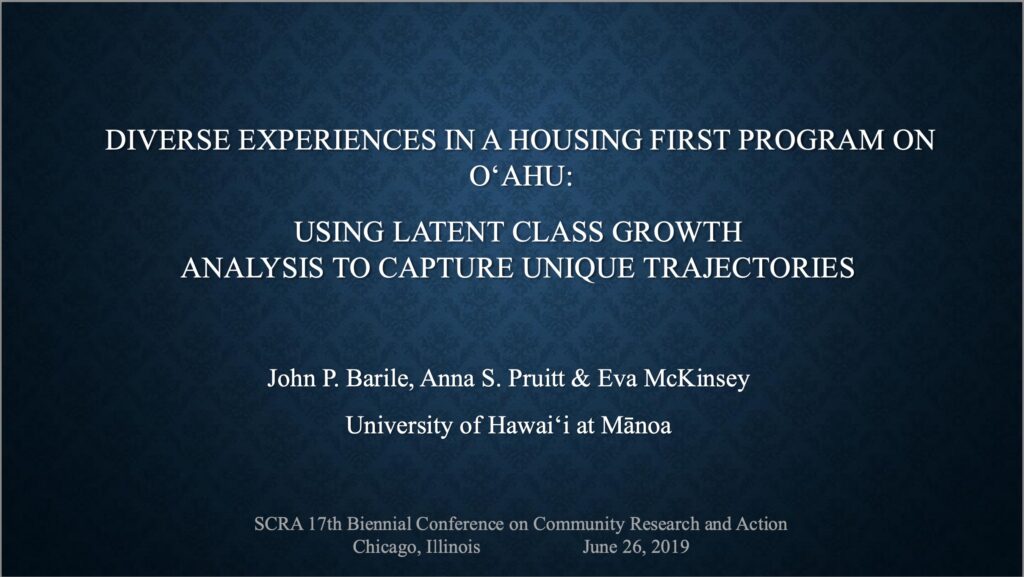
Barile, J. P., Pruitt, A. S., McKinsey, E. (2019). Diverse experiences in a Housing First Program on O‘ahu: Using latent class growth analysis to capture unique trajectories. Paper presented at the Society for Community Research and Action Biennial Conference, Making an Impact: Ecological Praxis: System Complexity, Cycles of Action, and Extending our Metaphors with the Natural World, Chicago, I.L.
Abstract
Often community intervention researchers focus primarily on identifying generalizable program outcomes, assuming equal effectiveness for all participants. This narrow focus neglects program participants’ diverse needs and outcomes. This presentation will focus on the diverse experiences of participants in a Housing First program on O‘ahu. The Housing First model eliminates traditional housing prerequisites (e.g., sobriety, psychiatric treatment), with the aim of moving program participants into permanent, supportive housing as quickly as possible (Tsemberis, Gulcur, & Nakae, 2004). The Housing First model has a strong evidence base and is deemed an effective approach to addressing homelessness, even in the presence of mental illness and substance abuse (Padgett, Gulcur, & Tsemberis, 2006). Despite widespread adoption of the model and considerable research on program outcomes, minimal research has examined within-setting differences experienced by Housing First participants. The current study tested a series of latent class growth models to identify unique trends over a four-year period. Monthly-reported quality of life data, participant histories, community engagement, and service delivery were used to identify the participants who followed unique trajectories over the course of the program. These findings have aided our work by identifying how services delivery can be amended to meet the specific and diverse needs of program participants and opened to door to pursuing new qualitative investigations. Our presentation will 1) highlight the diversity of participants entering the Housing First program; 2) demonstrate how their unique characteristics may have impacted their success in the program; and 3) recommend program adaptations that address the diverse needs of Housing First participants.
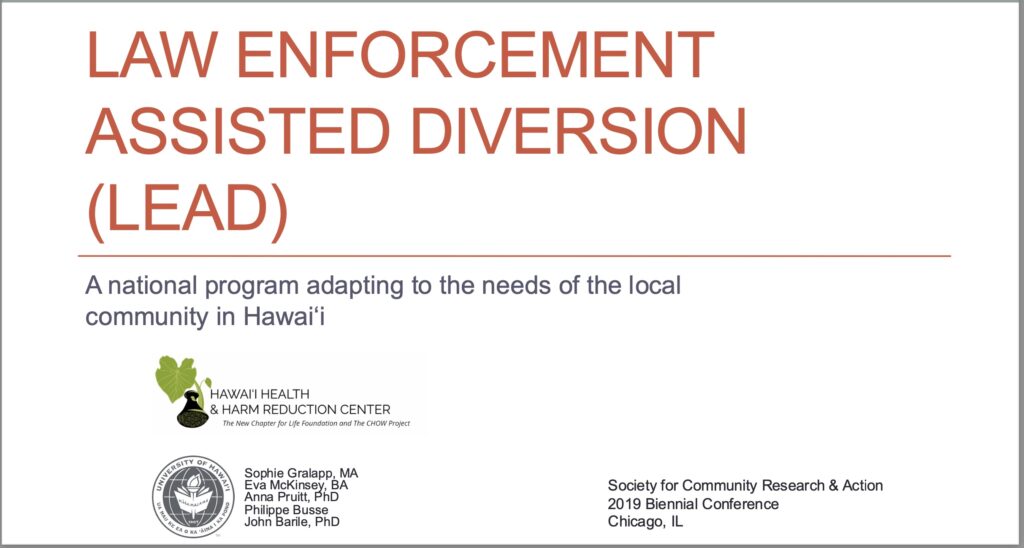
Gralapp, S., McKinsey, E., Pruitt, A. S., Busse, P., & Barile, J. P. (2019). Law Enforcement Assisted Diversion (LEAD): A national program adapting to the needs of the local community in Hawai‘i. Paper presented at the Society for Community Research and Action Biennial Conference, Making an Impact: Ecological Praxis: System Complexity, Cycles of Action, and Extending our Metaphors with the Natural World, Chicago, I.L.
Abstract
To be effective, programs need to be adapted to meet unique community contexts and interacting needs. Although this flexibility is important to program success, adaptations can also result in unique challenges and can threaten program fidelity. This presentation will focus on challenges and successes associated with adapting the Law Enforcement Assisted Diversion (LEAD) program to address homelessness in Honolulu, Hawai‘i. LEAD is a community-based, pre-booking diversion program in which law enforcement officers connect low-level, non-violent offenders or individuals at high-risk of arrest with social service providers in lieu of arrest (About LEAD, n.d.). While “LEAD-HI” initially was a response to the State of Hawai‘i’s need to address high recidivism rates and overcrowded correctional facilities, the program quickly adapted to respond to the overlapping issue of homelessness. Indeed, homelessness and incarceration are related social issues as chronic homelessness can be both a cause and consequence of incarceration (Fischer, Shinn, Strout, & Tsemberis, 2008; Greenberg & Rosenheck 2008). In Hawai‘i, an estimated 30% of the jail and prison population have ‘no fixed address’ (Thornton, Koshiba, & Lee-Ibarra, 2017). At referral, the large majority of LEAD-HI participants were currently experiencing homelessness (91%) and reported needing housing (88%). Therefore, while LEAD is not technically a housing program, LEAD-HI has adapted to address the demands of the community, which is overwhelmingly the need for housing. This presentation will discuss the challenges and successes associated with adapting a non-housing related program to address a community’s homelessness issue. Because community needs are not discrete, understanding program adaptations to address overlapping needs is important for community intervention research.
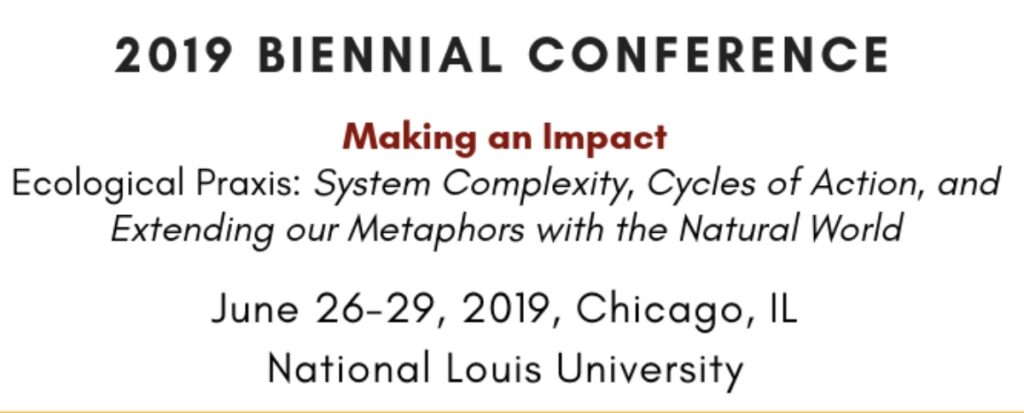
Cohen, S., Pruitt, A. S., Agner, J., & Barney, D. (2019). A Call for an ecological approach to understanding graduate student wellbeing. Roundtable led at the Society for Community Research and Action Biennial Conference, Making an Impact: Ecological Praxis: System Complexity, Cycles of Action, and Extending our Metaphors with the Natural World, Chicago, I.L.
Abstract
Research suggests that graduate students experience poor mental health and high levels of stress (Barreira et al., 2018; Evans et al., 2018; Mazzola et al., 2011). Evans and colleagues found that graduate students in their study were more than six times as likely to experience anxiety and depression than the general population. Within graduate student populations, women and transgendered students may be more likely to experience depression and anxiety than their male counterparts. A recent study has suggested that the growing rates of mental illness in graduate student populations indicate a “mental health crisis” in higher education (Evans et al., 2018). Much of the research examining graduate student mental health and wellbeing focuses on micro-level issues, such as imposter syndrome (Pishva, 2010), perfectionist-related characteristics and behaviors (Cowie et al., 2018), mentor-student relationships, and perceived work-life balance (Evans et al., 2018). Not surprisingly, suggested interventions often target the individual level, such as interventions that seek to change graduate student coping behaviors. In this roundtable, we turn to a broader, ecological discussion of graduate student experiences. We will discuss systemic-level issues that impact graduate student wellbeing, particularly for community psychology graduate students. For example, academic values of speed (finishing in a timely manner), competitiveness, and funding priorities are often at odds with community psychology values and practice, and navigating this mismatch has implications for mental and physical wellbeing. In addition to discussing multilevel impacts on graduate student wellbeing, this roundtable will discuss potential department strengths that can mitigate these impacts and future directions for researching and addressing this issue.
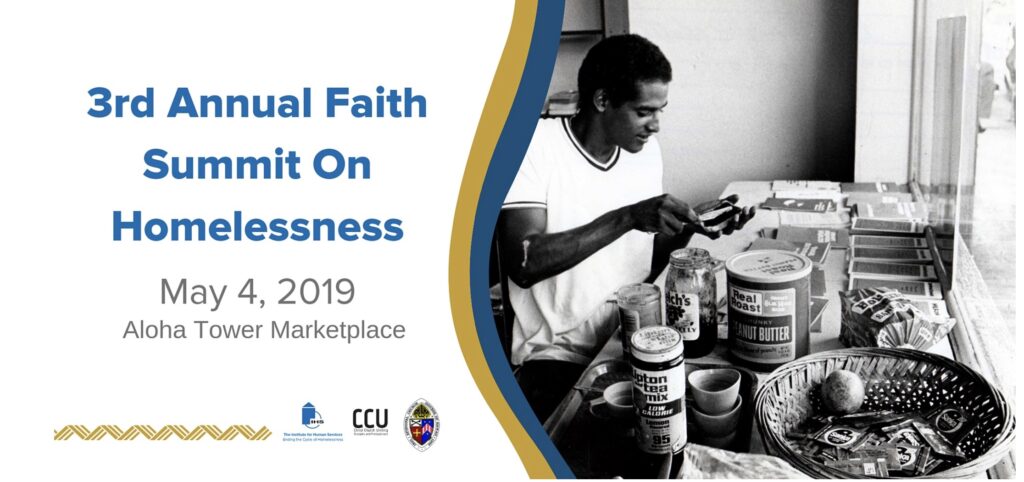
Monroe, S., Jesus, C., Pruitt, A. S. (2019). Highlighting the spiritual gifts of the homeless. 3rd Annual Faith Summit on Homelessness, Honolulu, H.I.
Abstract
Three perspectives on ministering to homeless persons matched to the gifts of unique ministry programs that empower people. Discussion will key in on the role of faith community members and the types of collaborations that work to effectively meet needs and unleash both the gifts of congregations and competencies of homeless people being served. A researcher will share what the data says about homeless people’s engagement with faith-based supports.
2018

Barile, J., Barney, D., Pruitt, A., Chow, D., & Shikuma, C. (2018). Quality of life of people living with HIV and fallen out of care: A need for reengagement. Roundtable presented at the American Public Health Association Annual Meeting, San Diego, C.A.
Abstract
A systematic review of the literature between 1996-2014 was unable to identify a single study on an intervention designed to re-engage individuals into HIV care (Higa & Mullins, 2016). Furthermore, little is known regarding the health and service needs of people living with HIV (PLWHIV) who have fallen out of care. This presentation will characterize the health and well-being of PLWHIV who have fallen out of care and identify opportunities for re-engagement. methods: Twenty-five PLWHIV with detectable viral loads who had fallen out of care were recruited to participate in an intensive case management program. This study used a mixed-method approach that included chart reviews, acuity assessments, participant surveys and direct one-to-one interviews. results: Upon entry in the program, the vast majority of participants reported fair or poor health (63%), considerably higher than the general adult population of the area (14%; 2016 BRFSS). Similarly, 50% of program participants reported experiencing over 14 physically unhealthy days in the past month (compared to 8% regionally) and 50% experiencing over 14 mentally unhealthy days in the past month (compared to 8% regionally). Furthermore, over 66% reported using illegal drugs a couple times–to–everyday in the last month and acuity assessments classified 80% of the participants as needing intensive mental health services. conclusions: People who have fallen out of care have significantly lower quality of life than the general population, suggesting that interventions seeking to re-engage these individuals should target physical and mental health issues while providing instrumental services.
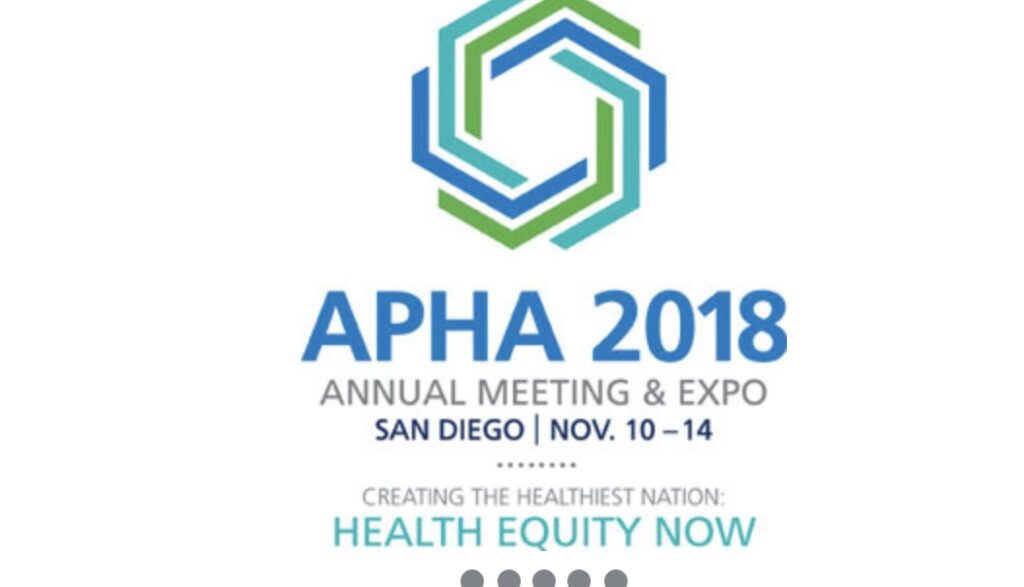
Barney, D., Barile, J., Pruitt, A., Chow, D., & Shikuma, C. (2018). HIV Treatment as prevention: Barriers and protective factors to treatment engagement. Paper presented at the American Public Health Association Annual Meeting, San Diego, C.A.
Abstract
Individuals not engaged in HIV treatment are more likely to come from disadvantaged backgrounds, experiencing difficulties across several life domains that may make any treatment engagement challenging. In Hawai‘i, Native Hawaiians are particularly vulnerable to treatment loss and these disadvantages. Our study identified individual vulnerabilities to re-engagement in HIV treatment and barriers against/protective factors to maintaining treatment for people living with HIV (PLWHIV) who have fallen out of care on O‘ahu, HI. This presentation will discuss these findings and suggest ways to improve care. methods: We present findings from an ongoing mixed methods investigation of a case management intervention aimed at re-engaging PLWHIV who have fallen out of care. An intensive case management program was introduced to individuals (n=25) with a history of HIV treatment noncompliance and chronically detectable viral loads (VL > 200). All individuals were surveyed and interviewed by study staff every other month to identify barriers, protective factors, and methods to best meet clients’ individual needs. results: Based on one-to-one qualitative interviews and service utilization records, we found that instability in housing, employment, transportation, social support, and mental health services were associated with difficulties engaging in treatment integration and that these issues often prevented later re-engagement. Preliminary findings suggest that individuals who have received case management and reengaged in HIV care have benefited from increased stability of these life dimensions, with increased HIV education as an emergent protective factor. conclusions: Preliminary findings suggest that interventions that target these barriers encourage retention and re-engagement in HIV care.
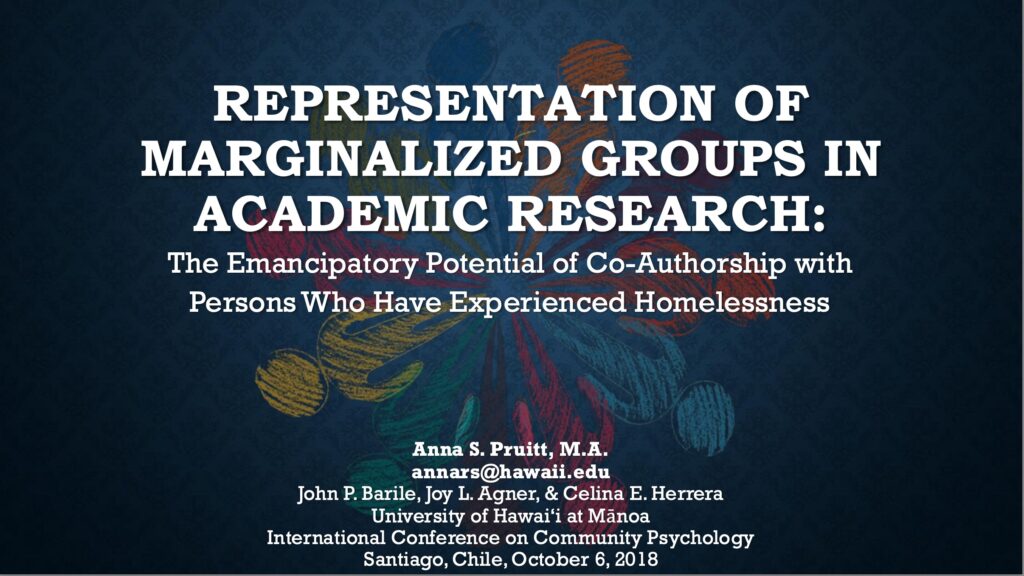
Pruitt, A. S., Barile, J. P., Agner, J. L., & Herrera, C. E. (2018). Representation of marginalized groups in academic research: The emancipatory potential of co-authorship with Housing First clients. Paper presented at the International Conference on Community Psychology, Santiago, Chile.
Abstract
Marginalized groups have historically had little voice in academic research, which has led to misrepresentation of these groups. Community-based participatory research (CBPR) has afforded marginalized groups a voice by including group members in the research process – from problem definition to dissemination. This inclusion helps ensure that research accurately represents and ultimately benefits the communities in which it is conducted (Israel, Schulz, Parker, & Becker, 1998). Despite its benefits, CBPR can be difficult to do equitably with vulnerable groups, particularly at the dissemination stage, due to time constraints and perceived lack of skills or capability (Case et al., 2014). These challenges are compounded when group members experience cognitive, mental, or physical vulnerabilities. However, inclusion in dissemination is crucial because it gives groups control over how they are represented to academic and community audiences. While CBPR academic literature often includes community members as co-authors, these members are frequently higher-powered stakeholders, such as community leaders. Co-authorship with members of marginalized groups who experience physical and mental health issues is rare.
This presentation will describe the process of co-authoring an academic article with a group of individuals who were dealing with mental and physical health issues and had recently experienced homelessness. Unfortunately, psychological literature on homelessness has tended to focus primarily on individual-deficits and deviancy (Buck, Toro, & Ramos, 2004). We hoped to challenge harmful representations of “the homeless” through a participatory publication. Published in 2018 in American Journal of Community Psychology, the resulting article presented findings from the group’s participatory Photovoice project that explored experiences with homelessness and a Housing First program (Pruitt et al., 2018). This presentation will discuss the successes and challenges of the co-authorship process, including reflections group members. It will conclude with lessons learned and implications for CBPR with vulnerable groups, especially in the dissemination phase of research.
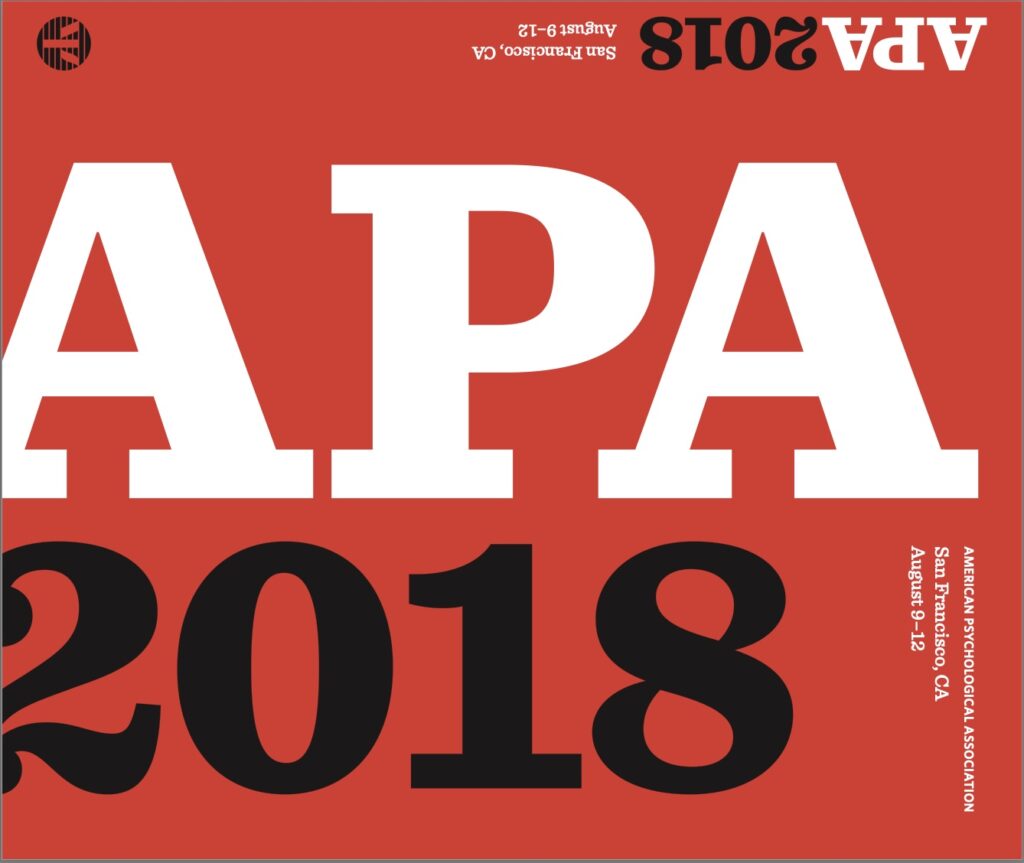
Barney, D., Pruitt, A. S., Agner, J., & Barile, J. P. (2018) Approaches to HIV treatment re-engagement and engaging systems of care. Poster presented at the American Psychological Association 2018 Convention, San Francisco, C.A.
Abstract
HIV treatment retention and re-engagement of individuals lost to care are of increasing concern. Nearly 50% of individuals in treatment for HIV drop out of care (Grimes et al., 2016). These individuals are more likely to come from disadvantaged/underserved backgrounds and to experience difficulties across several life domains that make treatment engagement challenging (Muthulingam et al., 2013). In Hawai‘i, Native Hawaiians are especially vulnerable to dropping from treatment and social disadvantage (Sentell et al., 2014). Given these intersecting difficulties, a wrap-around service model may be effective in increasing re-engagement in treatment, particularly in Hawai‘i. This study investigated the effectiveness of such an approach. This poster presents the preliminary results of an ongoing mixed methods investigation of a novel case management intervention, called Treatment as Prevention (TasP), aimed at re-engaging HIV-positive, non-virally suppressed individuals living on O‘ahu. These findings suggest that collaborative, wrap-around efforts initiated by clinicians, researchers, and community-based care partners increase individual re-engagement and may lead to improved overall HIV care and second-order change.
Our study included program participants (n=25) with chronically detectable viral loads (VL > 200) and a history of difficulty engaging in HIV treatment (or were at risk of falling out of treatment). These individuals were transferred from traditional case management (with caseloads over 100) to the intensive, strength-based case management program (caseloads capped at 25). Study staff surveyed and interviewed program participants at baseline and then every other month. The survey assessed health-related quality of life, barriers to care, access to healthcare, housing, social support, and community engagement. Interviews were transcribed and coded thematically.
Preliminary findings suggest that individuals receiving case management support addressing ancillary needs (e.g., housing, employment, transportation, social support, and mental health) demonstrated increased likelihood of returning to HIV treatment. Early findings also suggest that increased time per individual and the person-centered approach of the case manager were integral elements to re-engagement. Further, we found that collectively recruited efforts across the full system of care through wrap-around services was essential for effective support.
This study provided early evidence that interventions that lend support to individuals across meaningful life domains and engage multiple care providers into a coordinated network may be effective in re-engaging individuals previously lost to care.

Cohen, S., Marabella, G., Pruitt, A. S., & McKinsey, E. (2018). The ‘Ohana Approach: A call for culturally relevant evaluation designs based on CBPR principles. Poster presented at the Hawaiʻi-Pacific Evaluation Association 2018 Conference, Kaneʻohe, H.I.
Abstract
Community programs often must be culturally adapted to fit the needs of the target population (Galavotti et al., 2008; Wandersman et al., 2008). In turn, program staff can face difficulties balancing program fidelity to the model with necessary program adaptation. For example, the City and County of Honolulu’s Housing First Program Housing Year 3 Evaluation Report pointed to the program’s efforts to balance local cultural traditions, such as large families that include hanai family members, with program model stipulations requiring independent housing (Pruitt & Barile, 2018). Similarly, program evaluators of such programs must adjust their evaluation designs to reflect program cultural adaptions. Additionally, evaluators face difficulty in designing an evaluation that fits funder requirements and is culturally appropriate for the program and its participants. This poster addresses this difficulty by presenting a culturally adaptive evaluation design for the HF program using the “‘Ohana Approach.” The ‘Ohana approach is based in community-based participatory research (CBPR) principles and Native Hawaiians/Pacific Islander (NHPI) values. For example, instead of focusing on the progress of the individual, the ‘Ohana approach is primarily rooted within indigenous cultural ideals regarding family and community to ignite progress – allowing a solid, yet expansive, foundation for transformative change to occur. The poster will first briefly define the approach and then, will present an evaluation design for the HF program based on these principles. With 49% of Housing First (HF) clients being NHPI (Pruitt & Barile, 2018), taking a family/‘Ohana oriented evaluation approach that uses CBPR methods and honors holistic cultures of NHPIs has transformative potential for families as well as the extended community.
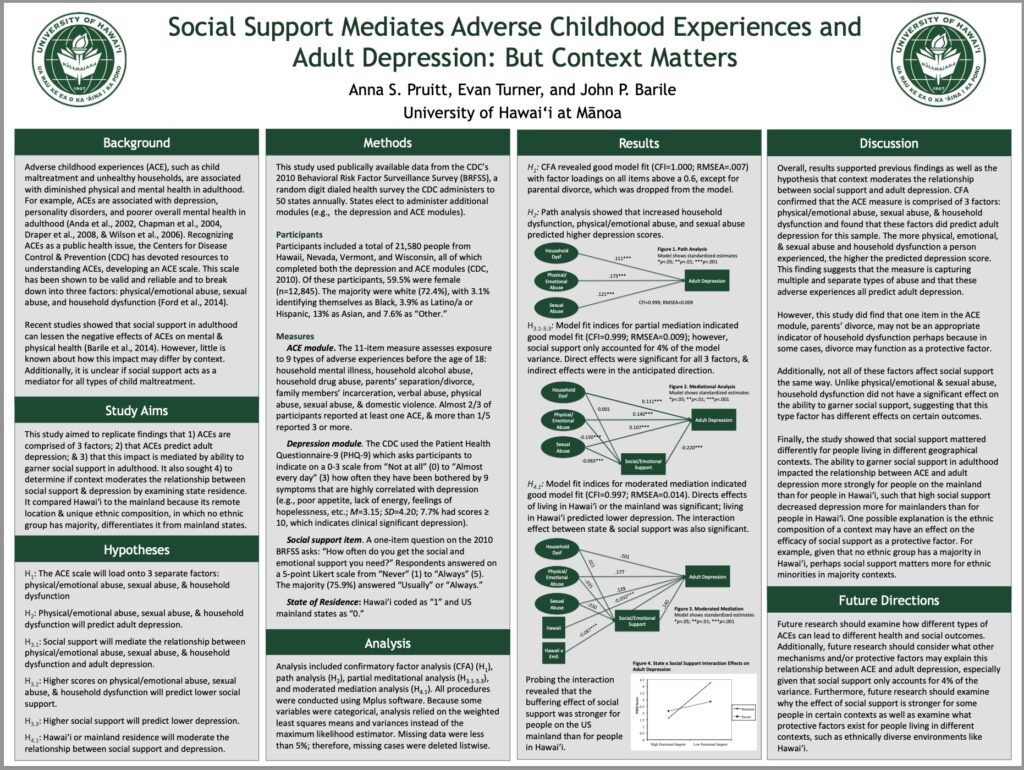
Pruitt, A. S., Turner, E., & Barile, J. P. (2018). Social Support mediates Adverse Childhood experiences and adult depression: But context matters. Poster presented at the Association for Psychological Sciences 2018 Convention, San Francisco, C.A.
Abstract
Adverse childhood experiences (ACE), such as child maltreatment and unhealthy household environments, are associated with diminished physical and mental health in adulthood. For example, ACEs are associated with depression, personality disorders, and poorer overall mental health in adulthood (Anda et al., 2002, Chapman et al., 2004, Draper et al., 2008, & Wilson et al., 2006). A recent study showed that social support in adulthood acts as a protective factor, lessening the negative effects of ACEs on mental and physical health (Barile et al., 2014). Despite these gains in understanding ACE impacts, adult depression, and the role of social support as a protective factor, little is known about how these associations may differ by context. The purpose of this study was to replicate previous finding that show 1) ACE is comprised of 3 sub-factors (Ford et al., 2014); 2) that these sub-factors predict adult depression; 3) and that this impact is mediated by the ability to garner social support in adulthood (Barile et al., 2014). Additionally, this study examined these associations 4) to determine if state of residence moderated the relationship between social support and adult depression.
This study used publically available data from the Center for Disease Control and Prevention’s (CDC) Behavioral Risk Factor Surveillance Survey (BRFSS), a random digit dialed health survey that the CDC administers across all fifty states annually. States may elect to administer additional modules, such as the depression scale or ACE module. Participants included a total of 21,580 people from Hawaii, Nevada, Vermont, and Wisconsin, all of which completed both the depression and ACE modules (CDC, 2010). Using confirmatory factor analysis, path analysis, meditational analysis, and moderated mediation analysis, this study confirmed previous findings as well as found a significant interaction effect between social support and state of residence (b=-0.087, SE=0.008, p<.001). Probing the interaction revealed that the buffering effect of social support on the impact of ACE on adult depression was stronger for people living on the US mainland than for people living in Hawai‘i. One possible explanation is that the ethnic composition of a context may have an effect on social support as a protective factor. Future research should examine why the effect of social support is stronger for some people in certain contexts as well as examine what protective factors exist for people living in different contexts, such as ethnically diverse environments like Hawai‘i.
2017
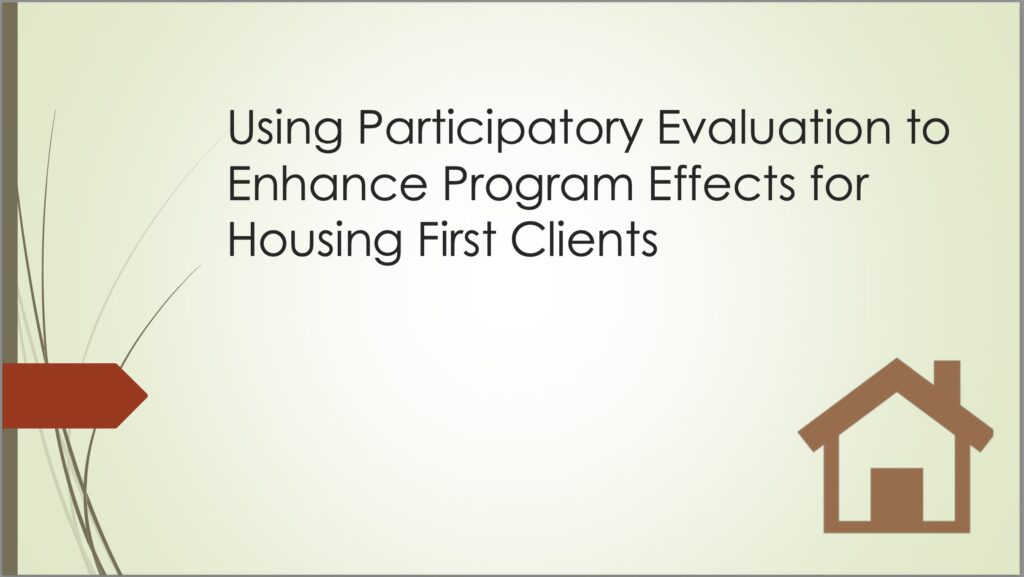
Pruitt, A. S., Barile, J. P., Anger, J., & Gralapp, S. (2017). Using participatory evaluation to enhance program effects for Housing First clients. Paper presented at the American Evaluation Association Annual Conference, Washington D.C.
Abstract
Despite the fact that community mental health programs have adapted to become more participatory and consumer-driven, evaluations of these programs continue to rely on traditional hierarchical evaluation methods. Additionally, participatory evaluations that do exist often involve higher-powered stakeholders, such as program staff and funders, and exclude stakeholders with traditionally less power but “high legitimacy” – the program participants. Unfortunately, even fewer examples of participatory evaluations exist with program participants who are highly vulnerable and experiencing mental illness, substance abuse, and/or homelessness. This presentation will examine the unique challenges and benefits of conducting a participatory evaluation with highly vulnerable clients in a consumer-driven Housing First program. It will demonstrate that in addition to better fitting program values and producing more ecologically valid results, taking a participatory approach to evaluations with vulnerable groups can enhance program effects, increase client empowerment, and lead to multi-level change.
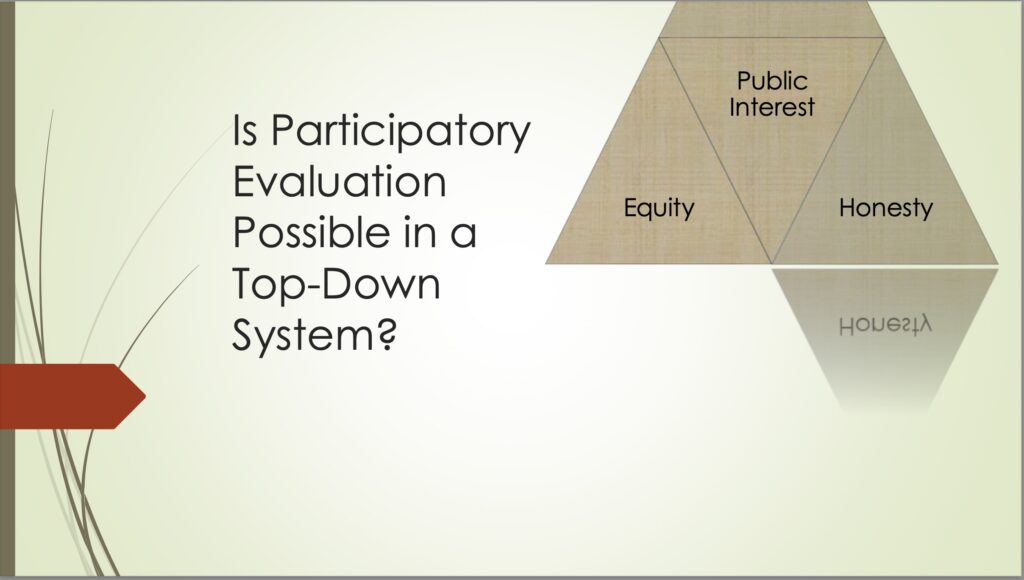
Agner, J., Gralapp, S., Pruitt, A. S., & Barile, J. P. (2017). Is participatory evaluation possible in a top-down system? Paper presented at the American Evaluation Association Annual Conference, Washington D.C.
Abstract
Participatory evaluation approaches differ from conventional evaluation approaches in that they emphasize shared decision-making, reduce power differentials between stakeholders, utilize diverse forms of data collection, and involve stakeholders in all aspects of the evaluation process including question development. This approach to evaluation is gaining momentum among evaluators who work within a social justice lens. However, social service agencies that serve marginalized communities often operate in a top-down, hierarchical fashion, where participatory approaches are not a natural fit. This conflict leads to logistical and ethical questions such as: 2) can participatory evaluation approaches work well in hierarchical settings? And 3) do evaluators have a responsibility to subtly challenge power dynamic in hierarchical social service organizations if they see potential for improving program outcomes? Examples are provided from evaluations of government funded programs in child welfare and mental health, and audience members will be asked to share perspectives from their own work.
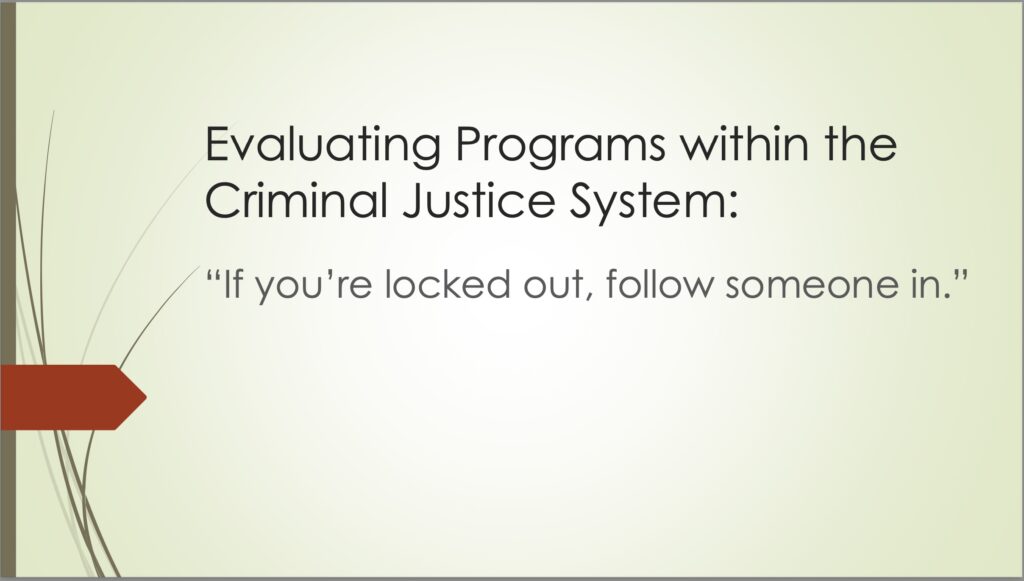
Gralapp, S., Agner, J., Pruitt, A. S., & Barile, J. P. (2017). Evaluating programs within the criminal justice system: “If you’re locked out, follow someone in.” Paper presented at the American Evaluation Association Annual Conference, Washington D.C.
Abstract
Corrections is an infamously locked and broken system. Participatory evaluation is a tool for paving the road to reparation. However, the primary stakeholders – the inmates – are a protected, vulnerable, and inaccessible to evaluators. Without access to primary stakeholders, evaluators often rely heavily on employees/service providers. Unfortunately, gaining buy-in from these employees/service providers is challenging; they feel overworked, underappreciated, and underpaid, assuming an outsider wouldn’t understand. To gain buy-in, the evaluator must morph from outsider to insider, requiring time and trust. An unintended consequence of the evaluator’s metamorphosis is becoming vulnerable to issues associated with working in locked settings that employees/service providers face like vicarious traumatization resulting from regular proximity to trauma. Employees/service providers are also a vulnerable population, but an unprotected one. This presentation will identify systematic roadblocks to conducting participatory evaluations with a ridged, hierarchical institution, and review the potential for trauma to the participants and evaluators.

Barile, J. P., Agner, J., Pruitt, A. S., & Gralapp, S. (2017). Empowering programs with established systems: Evaluating the Clubhouse Model. Paper presented at the American Evaluation Association Annual Conference, Washington D.C.
Abstract
Clubhouses are intentional communities composed of consumers, referred to as “members,” who work side by side with staff to perform jobs essential to the operation of the Clubhouse. Clubhouse membership affords four primary rights: 1) a right to a place to come; 2) a right to meaningful relationships; 3) a right to meaningful work; and 4) a right to a place to return. Clubhouses are designed to empower members to become increasingly autonomous while still being part of a community. The Clubhouse model focuses on the qualities of the individual that can contribute to the productivity of the Clubhouse and serve as a perfect environment to employ empowerment evaluations. However, while largely directed by program participants, Clubhouses are still beholden to international standards for accreditation and outcome expectations dictated by the state of Hawai‘i. These potential contradictions along with illustrations of evaluation methods be utilized in Hawai‘i will be presented.
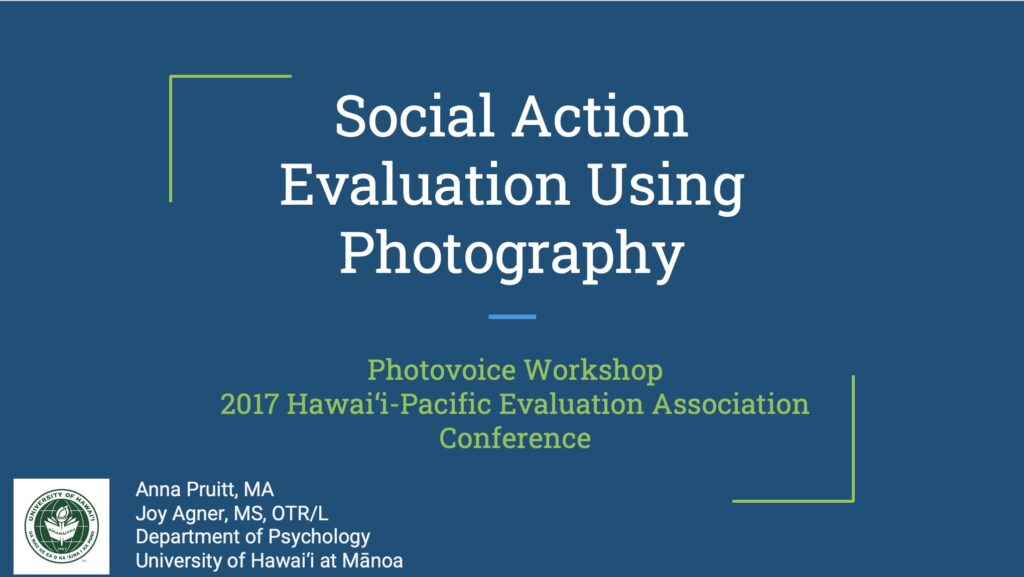
Pruitt, A. S., & Agner, J. (2017). Social action evaluation using photography: From needs assessment and program development to implementation and evaluation. Invited workshop given at the Hawai‘i-Pacific Evaluation Association 2017 Conference, Kanē‘ohe, H.I.
Abstract
“A picture is worth a thousand words,” so goes the old adage. Able to convey complex notions in a succinct form, photos can be powerful and persuasive tools. Photovoice, a participatory research methodology, uses photography, critical analysis, and group discussion to capture the perspectives and experiences of marginalized people in an effort to give voice to underserved communities and populations. Participants become active researchers at each stage of the research process, providing insight through their analysis of their photos and assisting in the dissemination of findings. This method is especially useful when evaluating programs that work with marginalized groups, youth, and indigenous populations. By giving program participants and stakeholders a voice in the evaluation, Photovoice can lead to more accurate accounts of people’s experiences with the program, resulting in richer and more valuable data. Although particularly beneficial when conducting evaluations for programs with marginalized groups, Photovoice also can be useful when engaging various stakeholders at different stages of evaluation – from engagement, needs assessment, and program implementation to process and outcome evaluations. This workshop will provide hands-on instruction for using Photovoice in various evaluation projects, with an emphasis on the ultimate goal of Photovoice: to achieve social action through the dissemination of the results.
Participants will:
- Learn how Photovoice has been used in evaluations and research that work with different underserved communities and populations;
- Learn how different populations can be engaged through community-based participatory action research (CB/PAR) to achieve project and evaluation goals;
- Practice analyzing photos in a Photovoice format; and
- Explore how social action may be facilitated through Photovoice projects.
Participants are encouraged to bring a picture answering the question: “What does evaluation look like for me/my organization?”
Format: Interactive with hands-on training in Photovoice
Target audience: Beginners to Intermediate
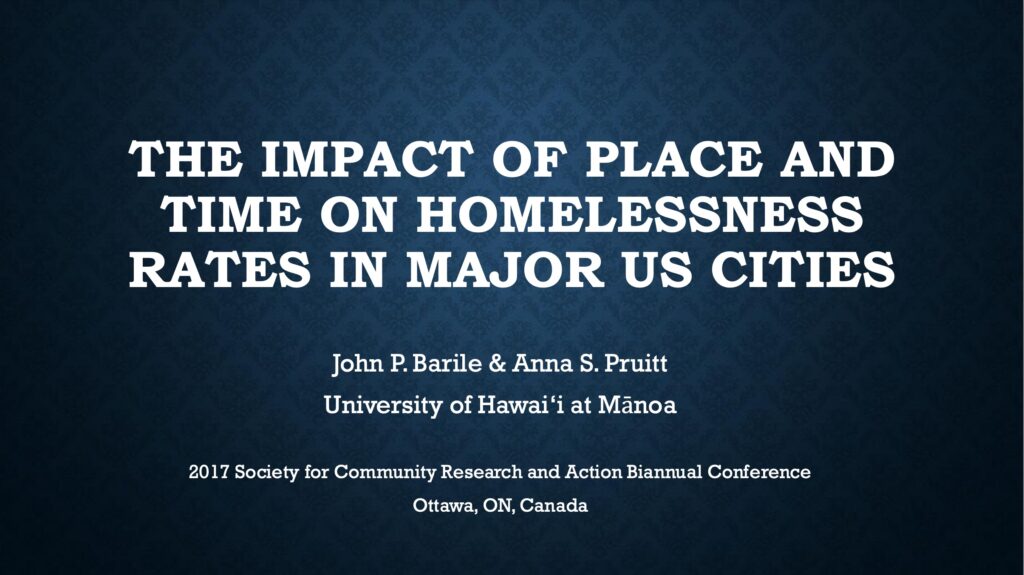
Barile, J. P., & Pruitt, A. S. (2017). The impact of place and time on homelessness rates in major U.S. cities. Paper presented at the Society for Community Research and Action Biennial Conference, Transformative Community Psychology, Ottawa, ON, Canada.
Abstract
Place and time can have a dramatic impact on homelessness rates. While there are likely many contributing factors, changes in the cost of affordable housing and the number of employment opportunities likely affect the number of individuals experiencing homelessness annually. Individual factors, such as substance abuse, medical conditions, educational obtainment, and [lack of] social support often determine who experiences homelessness, but community-level factors likely dictate how many individuals experience homelessness (McChesney, 1990; Shinn and Gillespie, 1994).
To date, little is known regarding the longitudinal associations among rental prices, employment opportunities, and homelessness rates in major US cities. Cities that have experienced dramatic increases in rental rates also report sharp rises in homelessness, despite substantial investment in social services. For example, in 2007, Seattle’s fair market rent for a one-bedroom apartment was $710, but by 2015, this rate had ballooned to $1,246 (U.S. Department of Housing and Urban Development, 2016). Over this same time, homelessness rates in Seattle jumped by 28%. Conversely, cities that have reported very modest rental increases since 2007 (e.g., Houston, TX, $138 increase and Fresno, CA, $99 increase) reported substantial decreases in homelessness over this same period.
While the total number of individuals experiencing homelessness has decreased nationally since 2007, it is unclear whether these declines are the result of more effective prevention and intervention programs or due to contextual changes, such as changes in rental rates, employment opportunities, or other community-level factors. This study will present findings based on archival and primary survey data to examine associations between community-level changes in rental prices and employment opportunities over time and changes in the number of individuals identified in annual point-in-time counts in 50 major US cities between 2007 and 2015. It will then present how these changes align with self-reported causes of homelessness at the individual level.
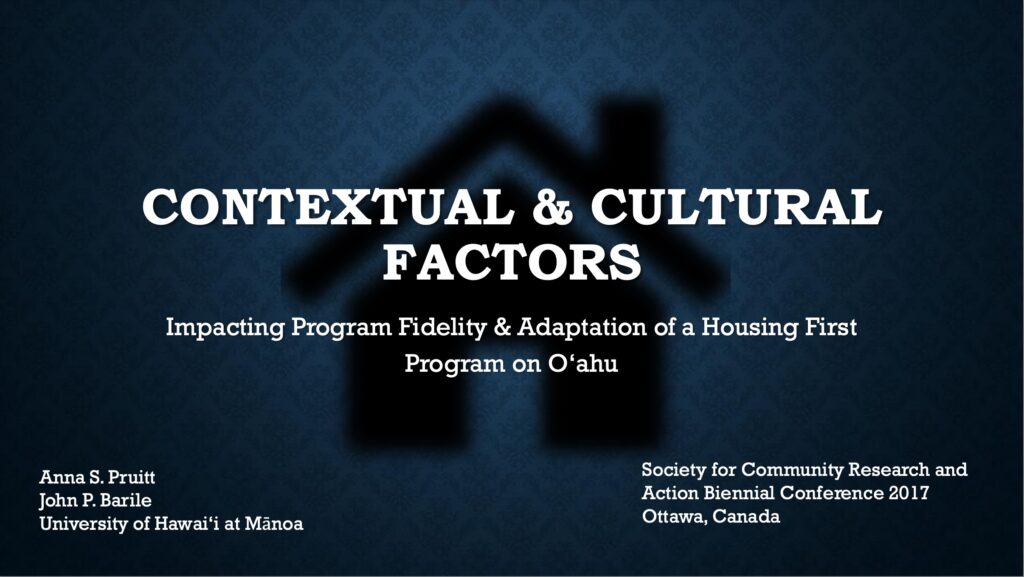
Pruitt, A. S., & Barile, J. P. (2017). Contextual and cultural factors impacting program fidelity and adaptation of a Housing First program on O‘ahu. Paper presented at the Society for Community Research and Action Biennial Conference, Transformative Community Psychology, Ottawa, ON, Canada.
Abstract
Contextual factors at systemic, organizational, and community levels not only affect individuals’ experiences of homelessness but also impact the implementation of housing programs designed to address this issue. In order to be effective, programs must be culturally appropriate and adapted to fit the needs of the target population (Galavotti et al., 2008; Wandersman et al., 2008). This presentation will discuss the ways in which a Housing First program (HF) on the island of O‘ahu adapted its model to respond to cultural, systemic, and community-level factors. Part of an ongoing four-year program evaluation, this study relied on data from a PhotoVOICE project (PV) with HF clients and in-depth interviews with program staff, case managers, clients, and landlords. Thematic coding of interviews and PV group transcripts revealed that the program made useful, creative adaptions to the model that addressed these contextual issues. For example, the staff explained that the high prevalence of large extended families in Hawai‘i impeded quick placement and client housing choice – important HF model criteria (Watson et al., 2013). Therefore, the program secured acceptable units as they became available so that staff could place families once they were vetted. Additionally, data revealed significant community and landlord stigma toward homeless individuals. However, there was also a public consensus that the island needed “to work together” to solve the “homelessness crisis” (see http://www.staradvertiser.com/homeless-in-hawaii). The program capitalized on the community’s general interest and openness to addressing homelessness by conducting community education designed to reduce stigma. One such educational event included a PV exhibit of clients’ photos and stories. Ultimately, this study showed that HF program implementation was enhanced by a flexible fidelity to the model and the addition of a community education component because these adaptations helped the program respond to contextual and cultural factors.
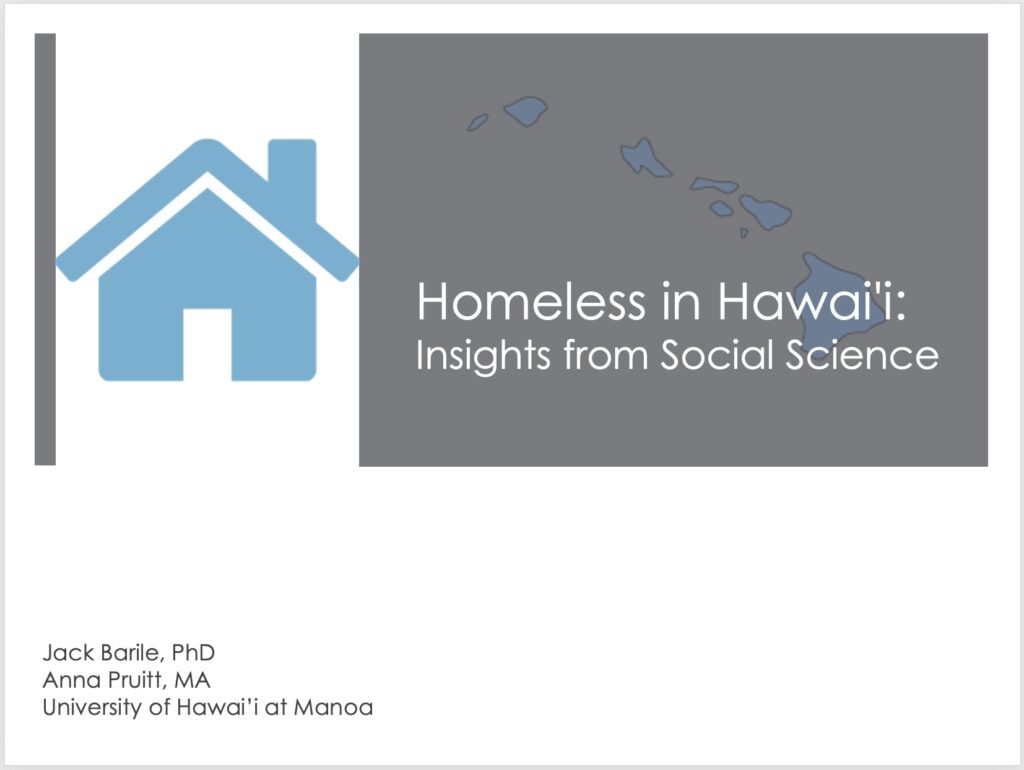
Darrah, J., Yuan, S., Liebreich, H., Liu, L., Barile, J. P., & Pruitt, A. S. (2017). Homeless in Hawaii: Insights from Social Science. Panel presentation for the Hawai‘i Sociological Association 38th Annual Conference: Land, Sea, and Food: Sociology and Environmental Change, Kanē‘ohe, H.I.
Abstract
Homelessness is one of the most pressing social problems facing Hawaiʻi. Social scientists have an important role to play in deepening and improving policy debates about homelessness. Panel members—faculty and students conducting research on homelessness—will share selected results from their ongoing research and evaluation projects and will discuss how their research sheds light on the state of homelessness in Hawaii. This panel aims to stimulate new research on homelessness in Hawaiʻi and to envision ways that social scientists can enhance public understanding and improve policy options. Panel members will discuss the following issues:
The state of homelessness in Hawaiʻi:
- What are the primary causes of homelessness in Hawaiʻi?
- How have local homelessness rates changed over time, and why?
- What best describes individuals experiencing homelessness in Hawaiʻi?
Addressing homelessness in Hawaiʻi:
- What data sources and evaluation techniques are being used to monitor progress in Hawaiʻi?
- What are the most promising policy and program interventions addressing homelessness?
The role of social science:
- How can social scientists studying homelessness address the limitations of media and policy discourses on homelessness in Hawaiʻi?
- What insights can social scientists bring to our understanding of the causes, consequences and potential solutions to homelessness in Hawaiʻi?
2016
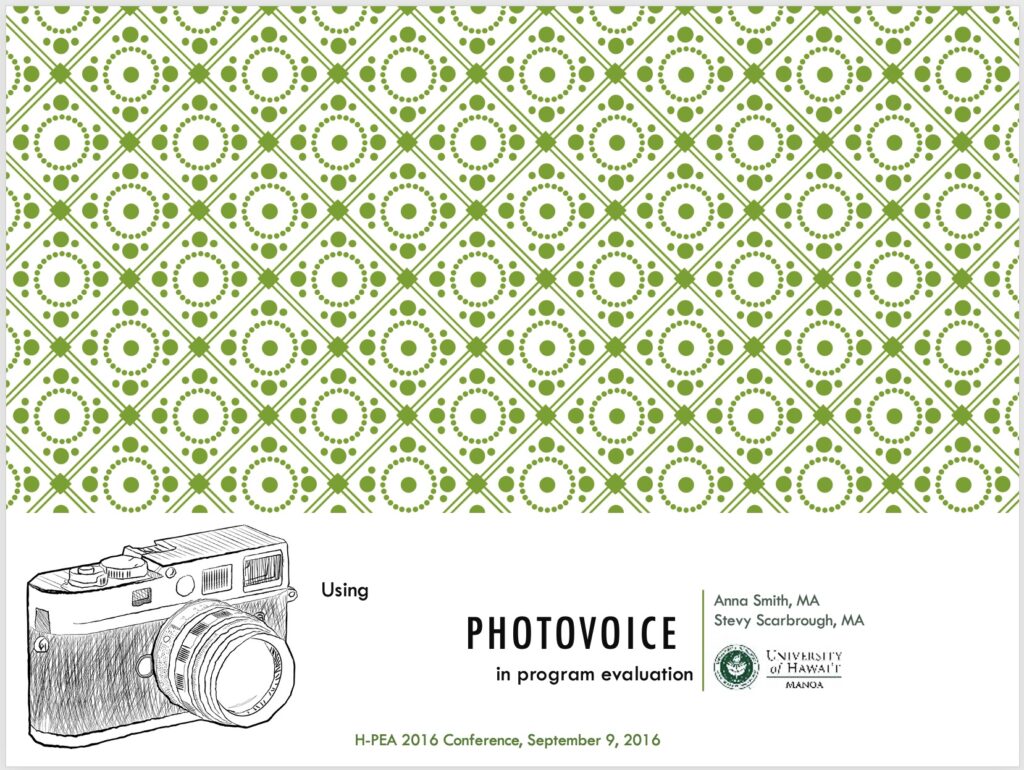
Smith, A. R. & Scarbrough, S. (2016). Using Photovoice in program evaluation. Demonstration presented at the Hawai‘i-Pacific Evaluation Association Conference, Demystifying Evaluation: Better Design for Useful Results, Kanē‘ohe, H.I.
Abstract
The purpose of this demonstration is to illustrate the advantages of using Photovoice methodology in program evaluation. Photovoice is a community-based participatory research methodology that uses photography, critical analysis, and group discussion to capture the perspectives and experiences of marginalized people. Based on feminist values of empowerment and Friere’s (1970) theory of critical consciousness, Photovoice puts cameras in the hands of community members and program participants and encourages collective knowledge-building and consciousness-raising through group discussions of photographs. Photovoice goals are three-fold: 1) to enable people to record their personal and community’s strengths and concerns; 2) to promote critical dialogue about the issues generated through photographs; and 3) to communicate these issues to policy makers in an effort to impact decisions that affect the community (Wang & Burris, 1997). Although initially used in community needs assessment, Photovoice methods are also useful in program evaluations, especially evaluations of programs that work with marginalized groups, youth, and indigenous populations. Because it includes marginalized people on the research team as fellow researchers – instead of as research subjects – Photovoice results in more meaningful data collection and empowerment of people to enact change on their own behalf. This demonstration will begin with a brief introduction to Photovoice as a methodology and its unique advantages for program evaluation, followed by a discussion on implementing Photovoice as part of an evaluation, conducting a mock group discussion. Finally, we will demonstrate how to conduct analysis of Photovoice data and how to report findings.

Smith, A., Barile, J. P., & Anger, J. (2016) Housing First Photovoice: When an evaluation becomes a program. Paper presented at the American Evaluation Association 2016 Conference: Evaluation + Design, Atlanta, G.A.
Abstract
Occasionally the lines between program and evaluation can become blurred. This presentation explores this phenomenon by discussing a photovoice project developed to elicit participant feedback on a Housing First program. Evaluators and program staff collectively designed the project, which resulted in a data collection process that resembled a program itself. Using participant-generated photographs and group discussions, photovoice is a useful participatory research method that empowers participants through consciousness-raising (Wang & Burris, 1997). This presentation explores the development of the photovoice project, its implementation, and results and discusses the challenges associated with using participatory research methods in program evaluation. Twenty participants contributed to the project over a four-week period. Findings generated through group discussions of participants’ pictures suggest that while they struggled to maintain a distance between their new lives and their old lives on the streets, program participants experienced improved self-esteem, physical health, and mental health since being housed.

Barile, J. P., Smith, A., & Agner, J. (2016). Housing First: Evaluating the program design, fidelity, and impact. Paper presented at the American Evaluation Association 2016 Conference: Evaluation + Design, Atlanta, G.A.
Abstract
Housing First is a community intervention that rapidly provides permanent, affordable housing to individuals and families experiencing homelessness. Housing First does not require individuals to demonstrate that they are “housing ready” before placement; instead, the program houses people first and then provides support services in the form of intensive case management to all individuals upon their initial assessment and throughout the housing process.
This presentation will provide an overview of our approach to monitoring the process and impact of a Housing First program initiated by the City and County of Honolulu in November of 2014. Since this time, over 200 individuals and families have been enrolled in the program. Using a mixed methods approach, our evaluation of the first year of the program found that despite adaptions to the program model, individuals and families enrolled in the program reported improved, physical health, mental health, and satisfaction with life.

Agner, J., Barile, J. P., & Smith, A. (2016). ICM-Plus: Developing sustainable evaluation tools through collaboration. Paper presented at the American Evaluation Association 2016 Conference: Evaluation + Design, Atlanta, G.A.
Abstract
One of the primary challenges in evaluation is designing tools that can be sustained by the organization itself. This presentation demonstrates how this challenge was encountered in an evaluation with an intensive case management plus program on Oahu, Hawai`i (ICM-Plus). ICM-Plus serves individuals, on average, 50 consumers who are facing housing insecurity, legal encumberment, medical and psychiatric instability, chronic lack of insurance, and substance abuse. While the ICM-Plus team members are expert at case management, their information management provided little insight to team members, management, or funding agencies about the quality of services. Through a collaborative, capacity building process, the evaluation team assisted in re-organizing existing data and analyzing it through growth modeling to show consumer change over time. While the immediate results of the evaluation serve a purpose, this presentation examines the challenges and successes of a broader goal: incorporating those designs into daily practice to promote evaluation sustainability.
2015

Barile, J. P., Smith, A. R., & Scarbrough, S. (2015). Evaluating the Housing First model: Intermediate processes and outcomes. Panel presentation given at the 41st Annual National Association for Rural Mental Health Conference: Ahupua’a: From the Mountains to the Sea, Honolulu, H.I.
Abstract
Housing First is a program designed to rapidly house individuals experiencing homelessness regardless of preexisting physical health, mental health, and substance abuse conditions (Pathways to Housing, 2013). The Housing First approach includes four principles: 1) homelessness is first and foremost a housing problem and should be treated as such; 2) housing is a right to which all people are entitled; 3) people who are homeless or on the verge of homelessness should be returned to or stabilized in permanent housing as quickly as possible and connected to resources necessary to sustain that housing; 4) issues that may have contributed to a household’s homelessness can best be addressed once the family is housed (The National Alliance to End Homelessness, p. 1, 2009). While the Housing First approach has shown promise in gaining stability for individuals with serious mental illness and/or histories of substance use (Padgett, Stanhope, Henwood, & Stefancic, 2011; Pearson, Montgomery, & Locke, 2009; Tsemberis, Gulcur, & Nakae, 2004), the mechanisms that lead to this stability are relatively unknown. In order to adequately understand the potential impact of the program, evaluators need to monitor key intermediate indicators believed to be associated with long-term housing stability, management of mental health conditions, and reductions in substance abuse.
An evaluation of the Housing First program on the island of Oahu, HI, delivered by The Institute of Human Services, has designed and implemented an evaluation methodology that includes close monitoring of likely intermediate processes associated with long-term housing stability, improvements in health, and reductions in visits to emergency room, inpatient hospital beds, and correctional facilities. This presentation will include an analysis of the theoretical processes underlining the Housing First model, with special attention paid to the intermediate processes necessary for individuals to maintain housing stability. These include monthly assessments of program participants’ social support (Sherbourne & Stewart 1991), perceived stress (Cohen & Williamson, 1988), ability to obtain needed health services, engagement in the community, satisfaction with life (Diener, Emmons, Larsen, & Griffin, 1985), and health-related quality of life (Centers for Disease Control and Prevention, 2000). These factors, along with measures of program implementation (i.e. fidelity to the model), will be used to demonstrate methods for evaluating the Housing First approach to addressing homelessness for individuals with a history of mental health and substance abuse conditions.
Learning Objective:
- To become aware of methodological approaches to conducting process and outcome evaluations
- To be able to identify key components of the Housing First approach to addressing homelessness
- To discover comprehensive tools used to evaluate intermediate outcomes of the Housing First approach to addressing homelessness for individuals with a history of mental illness and/or substance abuse
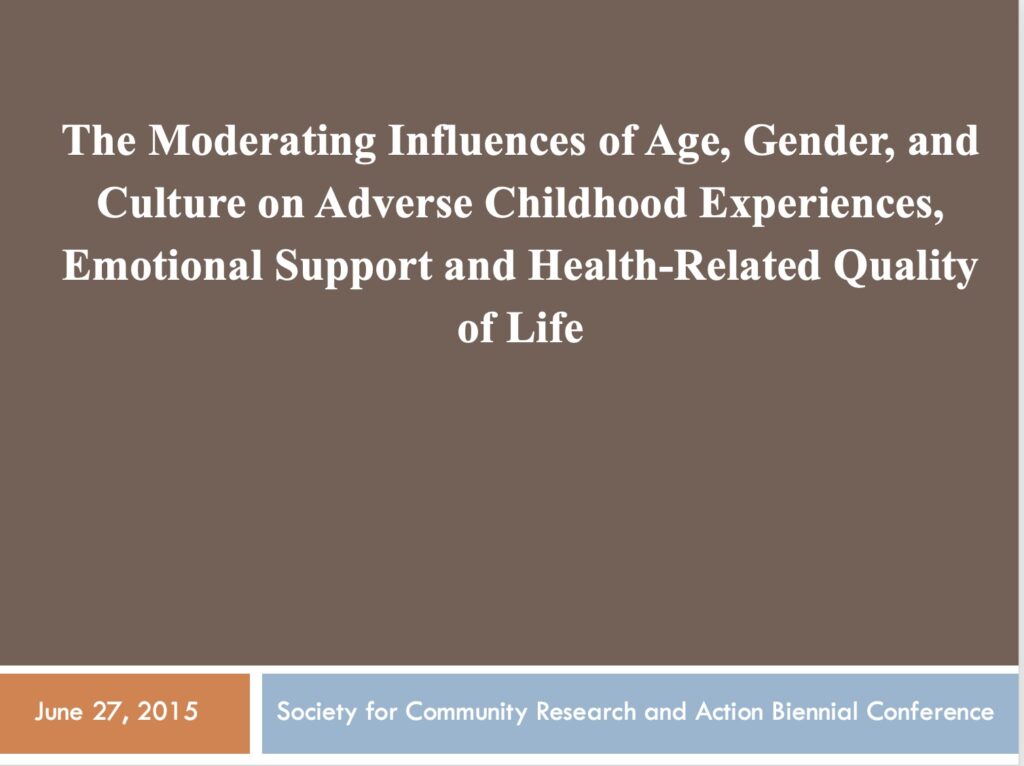
Smith, A. R., Barile, J. P., Scarbrough, S. M., Ford, D. C., Merrick, M. T. & Thompson, W. W. (2015). The moderating influences of age, gender, and culture on adverse childhood experiences, emotional support and health-related quality of life. Paper presented at the Society for Community Research and Action Biennial Conference, Bridging Past and Future, Lowell, M.A.
Abstract
This study investigated the moderating effects of gender and culture influences on the association between adverse childhood experiences (ACEs) and emotional support in adulthood. Additionally, it will examine whether the association between emotional support and health-related quality of life are dependent upon individuals’ gender, culture, age, and history of ACEs. ACEs are frequently associated with lower mental and physical health outcomes in adulthood, and this association has been found to be mediated by emotional support (Barile et al., 2014). However, the strength of the associations between ACE, emotional support, and HRQOL may depend on individuals’ unique experiences and cultural background. For instance, although both men and women encounter ACEs, women are more likely than men to seek out emotional support (Tamres, Janicki & Helgeson, 2002), which suggests that gender may affect both ability to achieve emotional support and adult HRQOL. Furthermore, a better understanding of culture and it’s influences and age related changes that may influence the relationship between ACEs, emotional support, and HRQOL may aid in the development of secondary prevention. We tested these associations utilizing structural equation modeling techniques based on data from the 2010 BRFSS. Our findings suggest that individual-level interventions that focus on emotional support as a protective factor for individuals who have experienced child maltreatment should consider assessing and accounting for the impact of moderating effects of gender, culture and age on their ability to garner emotional support and their impact on HRQOL.
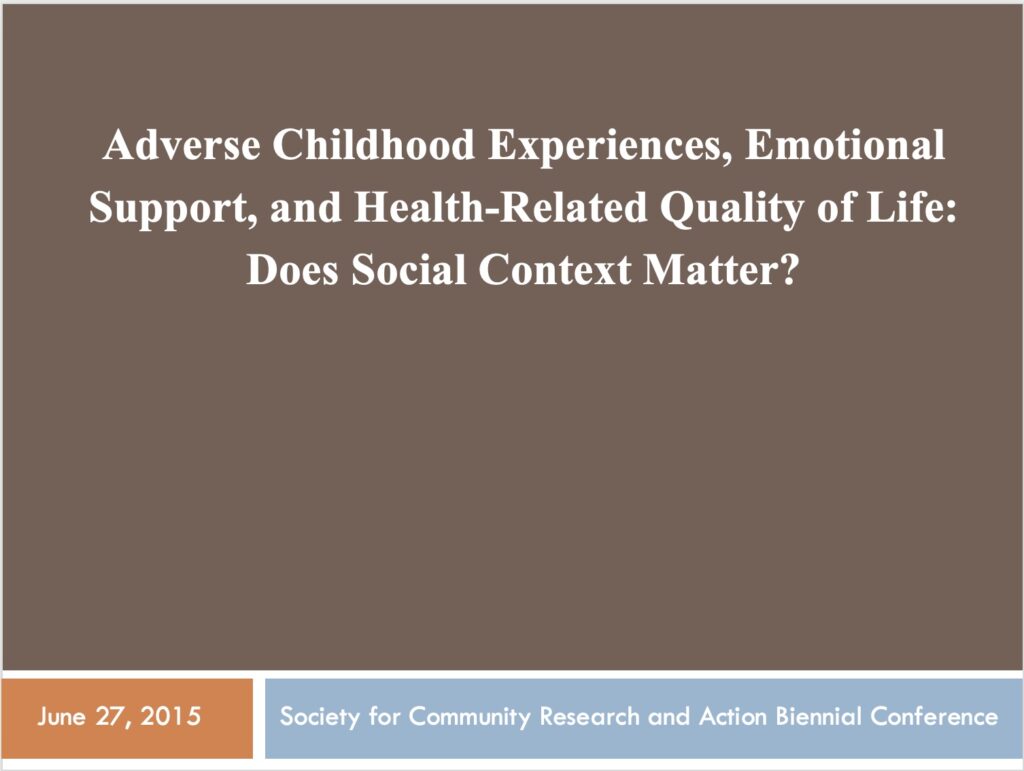
Scarbrough, S. M., Barile, J. P., Smith, A. R., Ford, D. C., Merrick, M. T. & Thompson, W. W. (2015). Adverse childhood experiences, emotional support, and health-related quality of life: Does social context matter? Paper presented at the Society for Community Research and Action Biennial Conference, Bridging Past and Future, Lowell, M.A.
Abstract
Adverse Childhood Experiences (ACEs) are almost exclusively researched and addressed at the level of the individual. The large majority of the research on ACEs has focused on individuals’ histories, coping skills, and distal outcomes such as chronic mental and physical health conditions. Few studies have addressed the potential compounding of risk factors that are common amongst individuals who experienced ACEs. By adulthood, these risk factors may increase the chances of them living in communities that are rife with violence, a lack of trust, and general social decay. Moreover, few studies have examined the impact that social determinants of health, including county level conditions, have on the health and well-being of individuals with a history of ACEs. This study seeks to garner a better understanding of the impact that these environments have on associations among ACEs, emotional support, and health-related quality of life (HRQOL) by utilizing data from the 2010 Behavioral Risk Factor Surveillance System (BRFSS). Results from this study suggest that the associations between ACEs and emotional support, and the association between emotional support and HRQOL are dependent upon the social environment in which individuals live. These findings also suggest that in order for individuals to best benefit from their available social supports, aspects of the social environment must also be considered. Consideration of these findings would likely improve individual-level focused interventions aimed at improving the lives of adults with a history of ACEs.
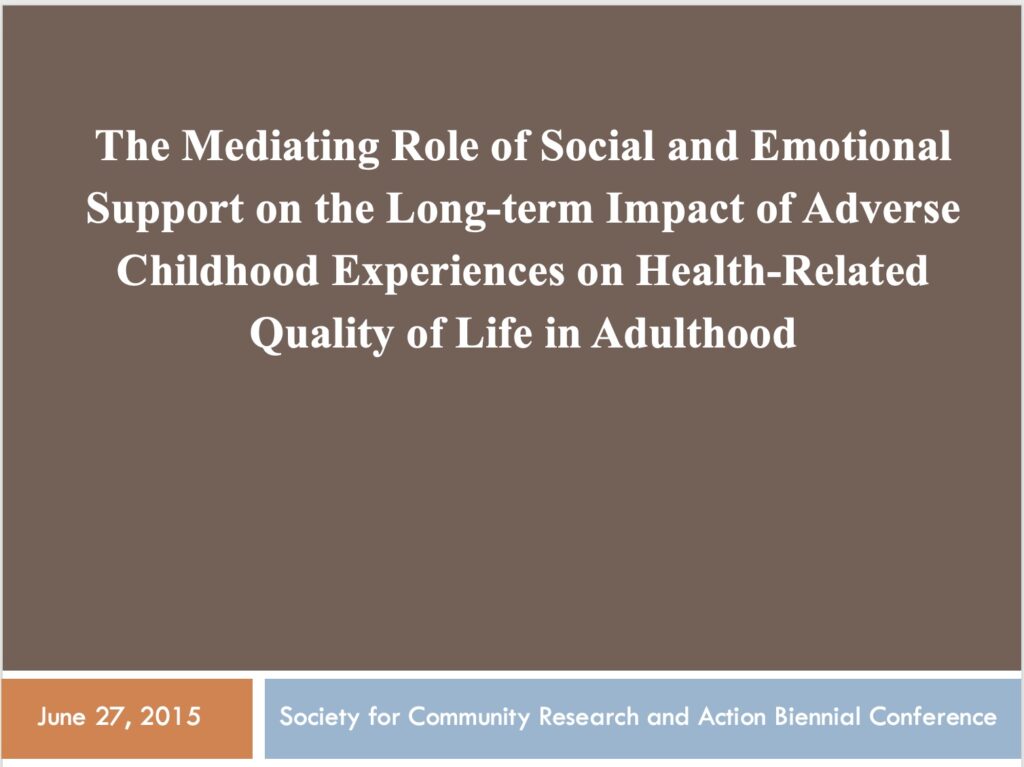
Barile, J. P., Ford, D. C., Scarbrough, S. M., Smith, A. R., Thompson, W. W., & Merrick, M. T. (2015). The mediating role of social and emotional support on the long-term impact of adverse childhood experiences on health-related quality of life in adulthood. Paper presented at the Society for Community Research and Action Biennial Conference, Bridging Past and Future, Lowell, M.A.
Abstract
Adverse Childhood Experiences (ACEs) such as childhood maltreatment and negative household environments have been repeatedly associated with poor physical and mental health. Previous studies have determined that ACEs are associated with depression (Anda et al., 2002; Chapman et al., 2004; Edwards, Holden, Felitti, & Anda, 2003), suicidality (Johnson et al., 2002), poorer overall mental health (Anda et al., 2002; Draper et al., 2008; Edwards et al., 2003; Wainwright & Surtees, 2002). Physical health problems associated with ACEs include ischemic heart disease (Dong, Giles, et al., 2004), chronic obstructive pulmonary disease (Anda et al., 2008), immune disorders (Dube et al., 2009), and mortality (Brown et al., 2009). This study will provide a review of the previous literature regarding measurement of ACEs, determine the strength of the associations between ACEs, emotional support, and health-related quality of life (HRQOL), and determine the strength by which the associations between ACEs and HRQOL are mediated by individuals’ ability to garner emotional support in adulthood. Utilizing data from the Centers for Disease Control and Prevention’s (CDC) Behavioral Risk Factors Surveillance System (BRFSS) from five states, our findings suggest that ACEs both directly and indirectly (via emotional support) impact individuals’ HRQOL in adulthood. The review will include an examination of the methods used to assess histories of ACEs, their measurement structure, and identify current gaps in research and practice.
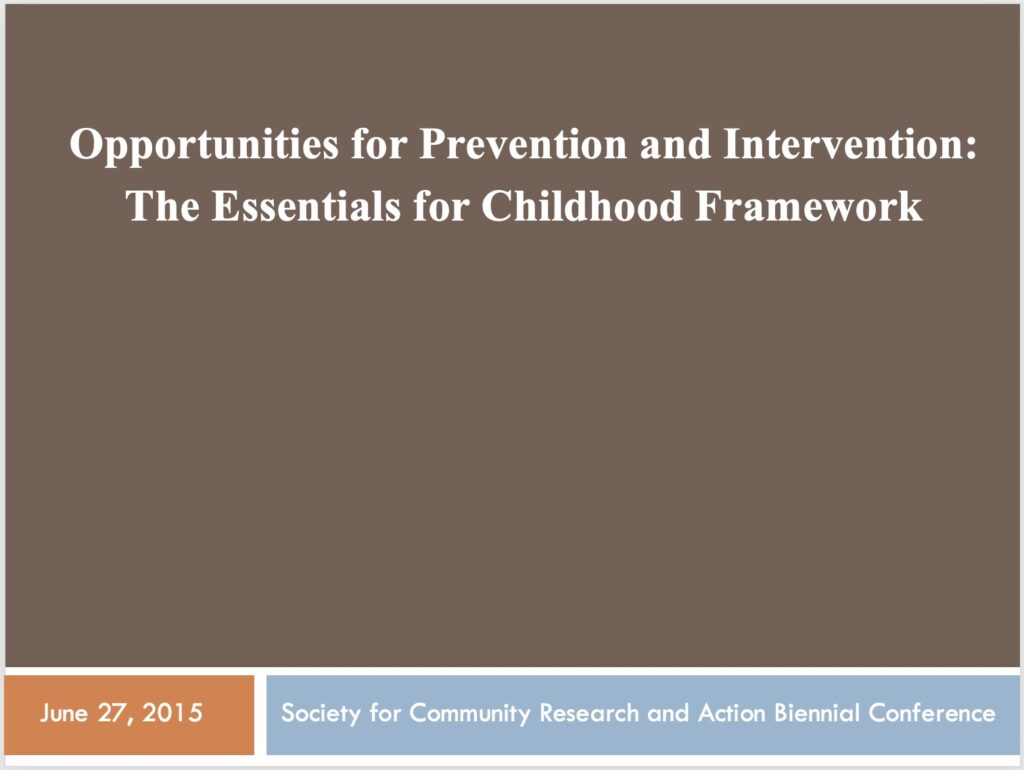
Ford, D. C., Merrick, M. T., Barile, J. P., Smith, A. R., Scarbrough, S. M., & Thompson, W. W. (2015). Opportunities for prevention and intervention: The essentials for childhood framework. Paper presented at the Society for Community Research and Action Biennial Conference, Bridging Past and Future, Lowell, M.A.
Abstract
Child maltreatment is a significant public health problem. It is also a preventable one. As demonstrated in the preceding presentations, identification of risk factors for adverse childhood experiences (ACEs) and their relationships to subsequent health problems is an important step in understanding the impact of child maltreatment on adult health and wellbeing. Further, identifying the contextual influences that may ameliorate the health of individuals exposed to ACEs is also paramount. As such, the child maltreatment field has begun to prioritize protective factors for children and families. The Centers for Disease Control and Prevention’s (CDC) Essentials for Childhood framework represents CDC’s vision for the prevention of child maltreatment by promoting strategies to assure safe, stable, nurturing relationships and environments for all children. This presentation will review the rationale for this approach and its key components, placing a premium on data informed action and the promotion of contexts that support safe, stable, nurturing relationships and environments through norms change, programs, and policies.
The findings and conclusions in these abstracts and associated presentations are those of the authors and do not necessarily represent the official position of the Centers for Disease Control and Prevention
